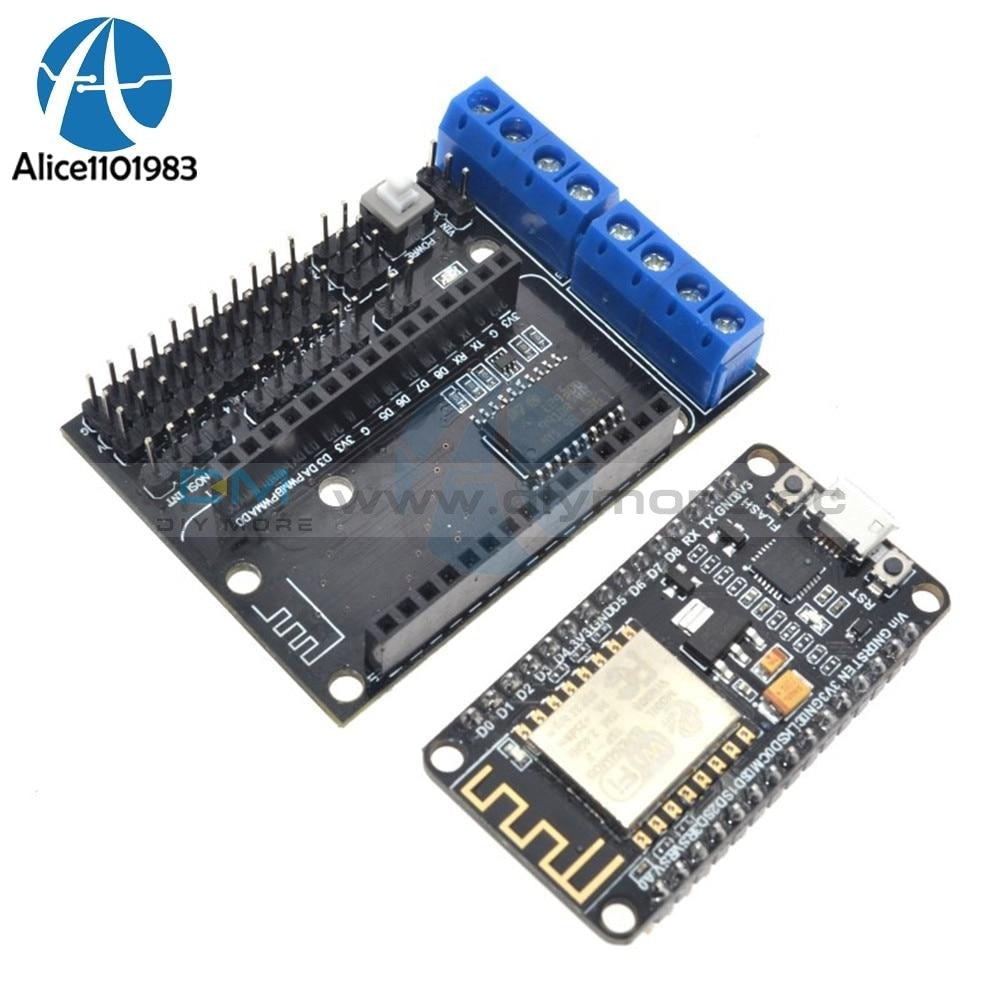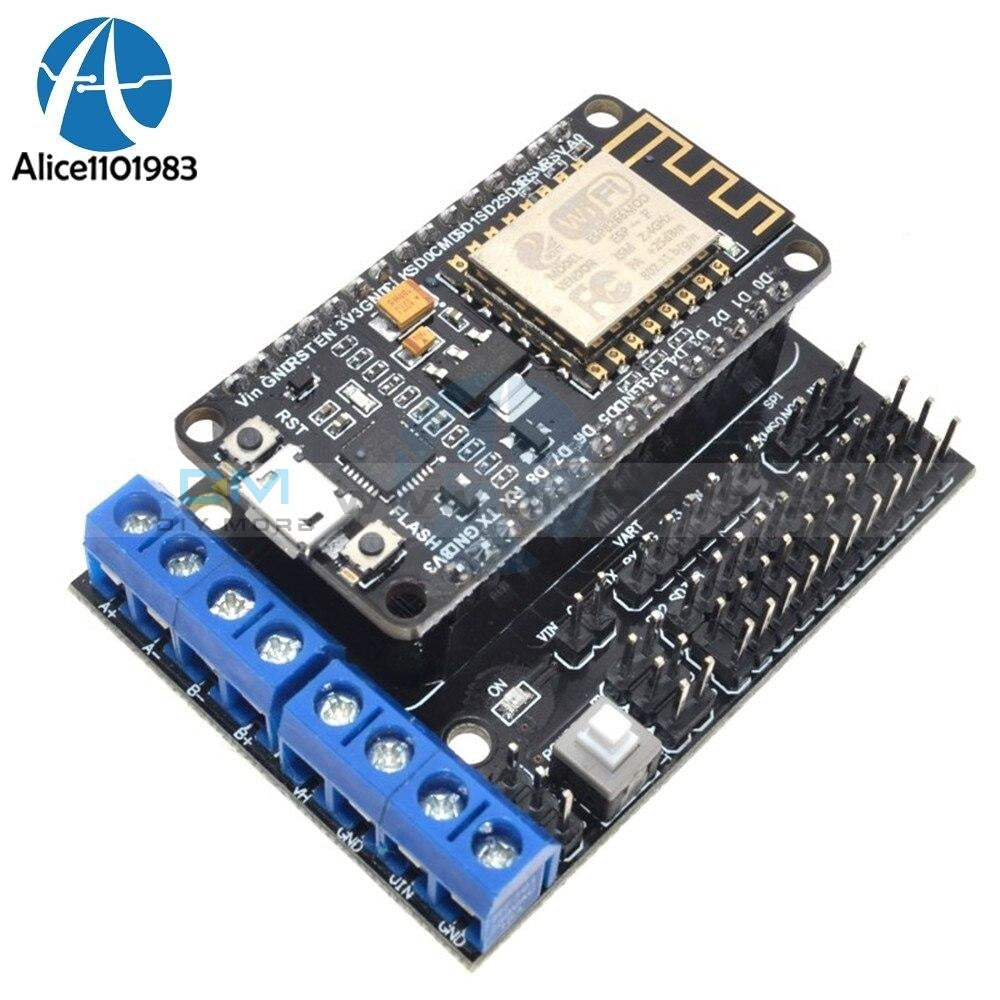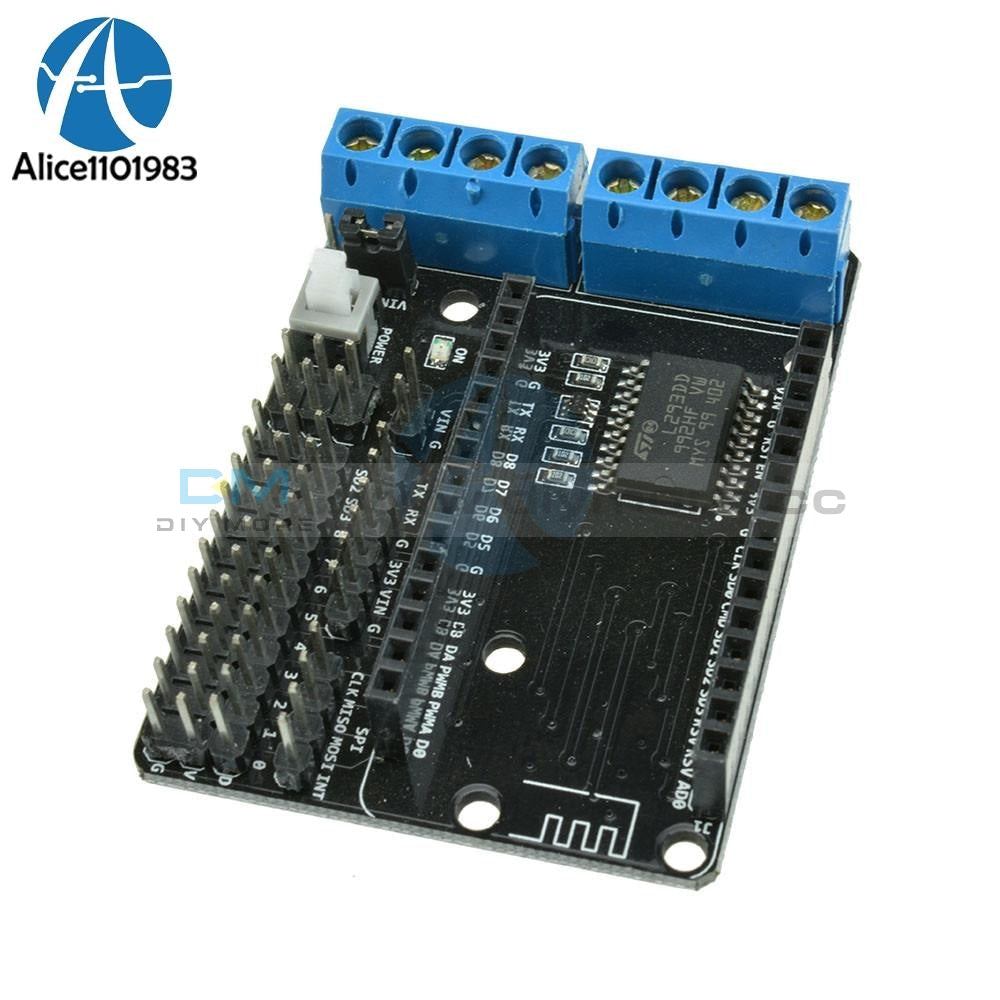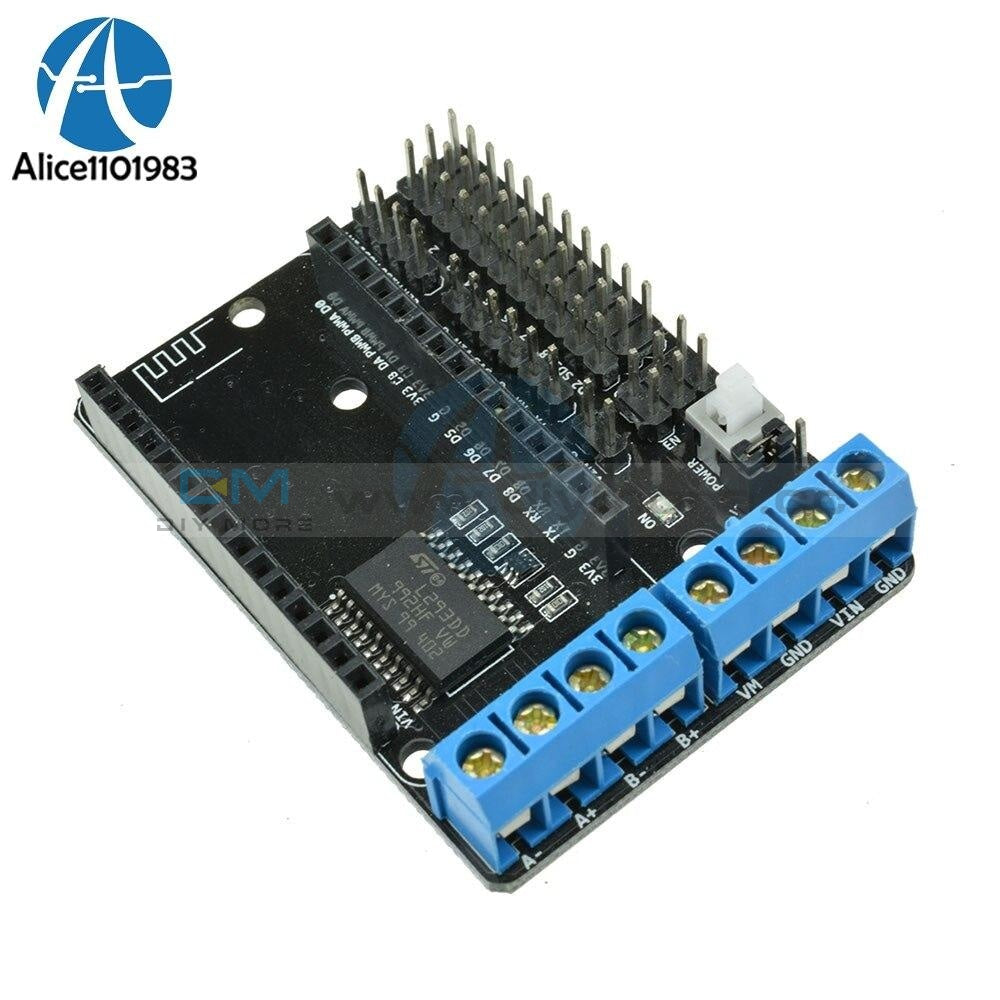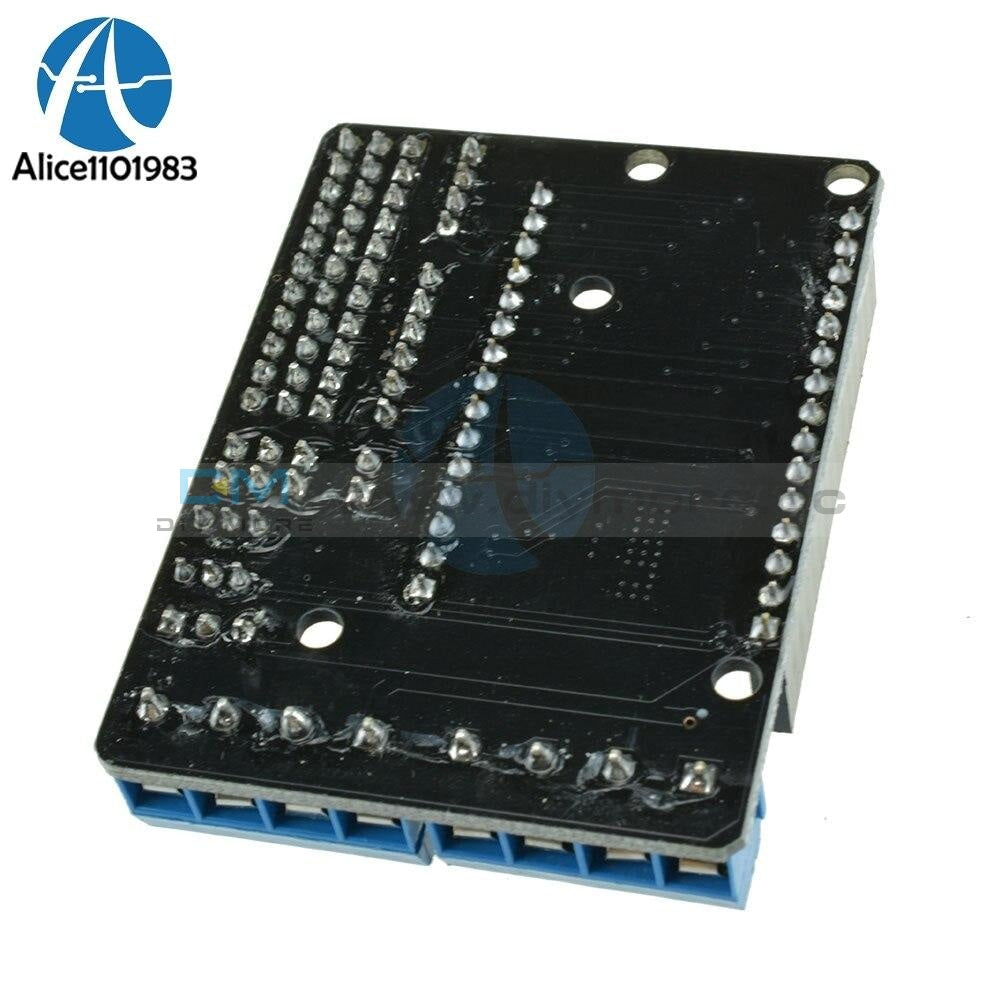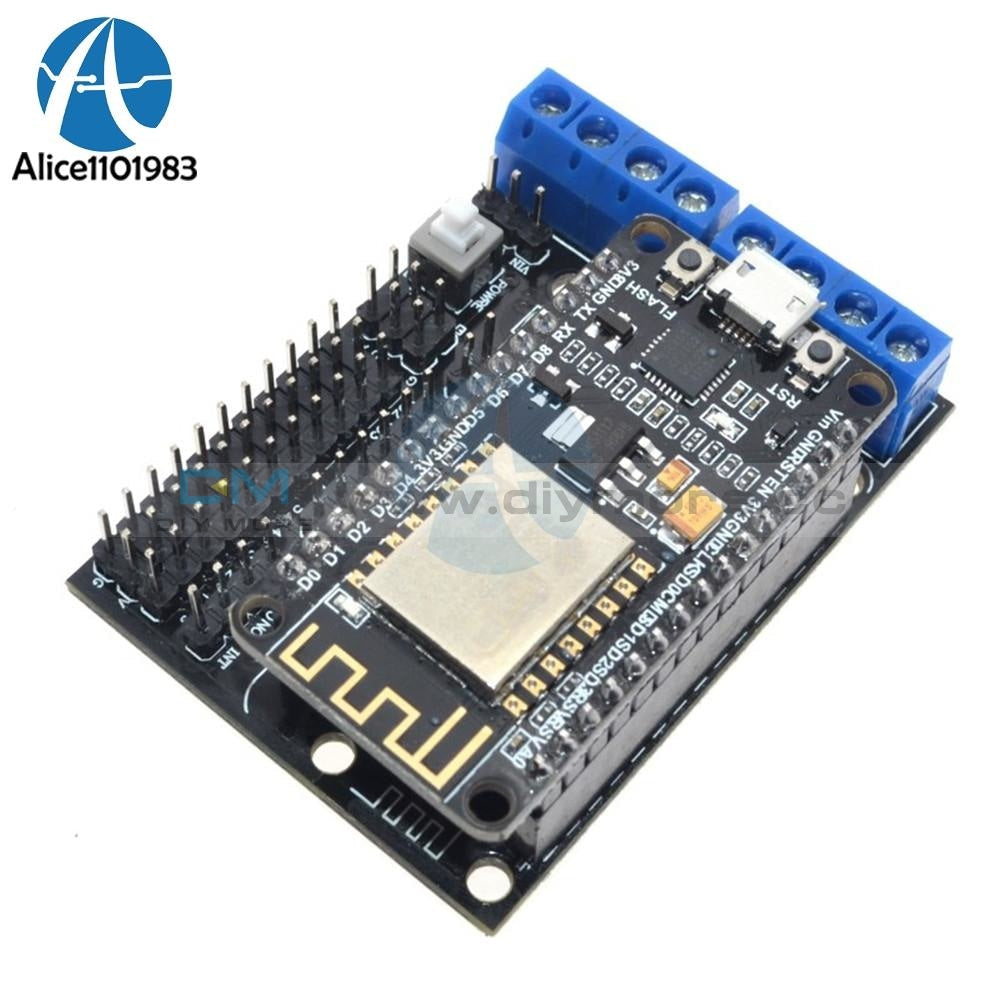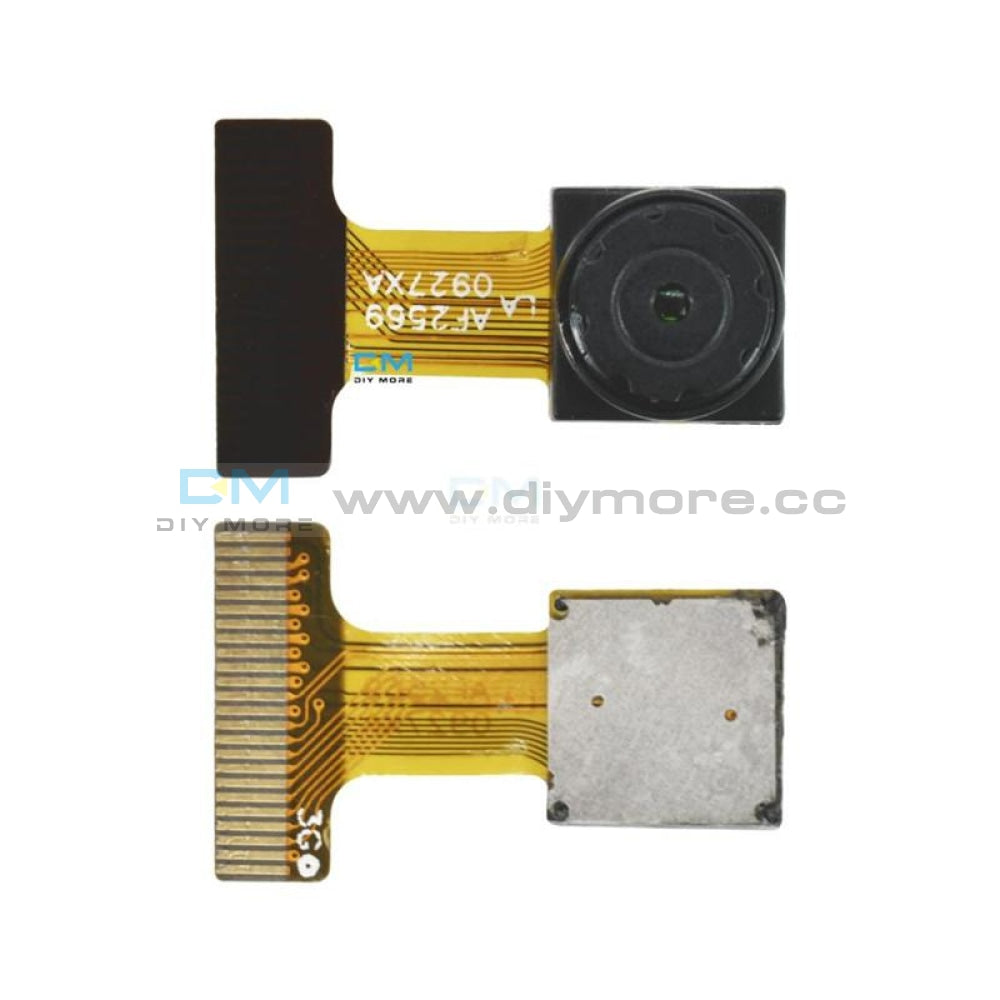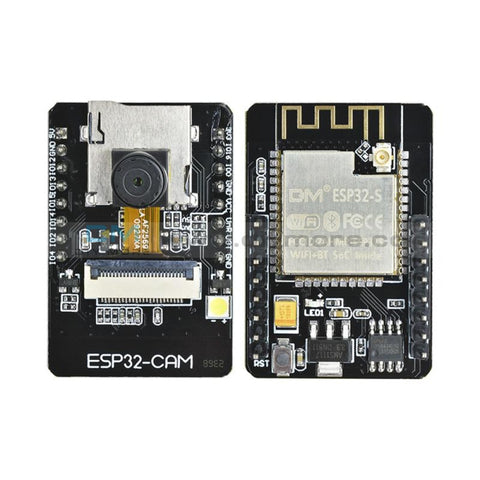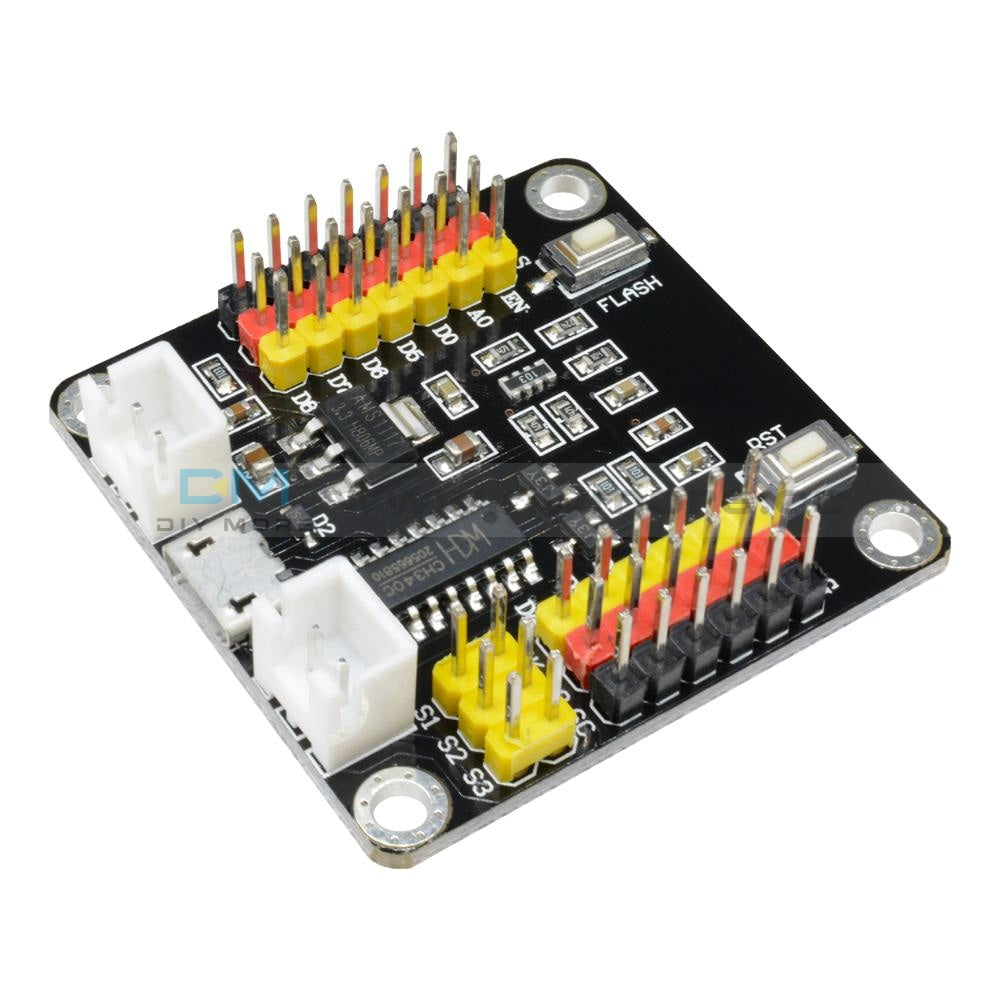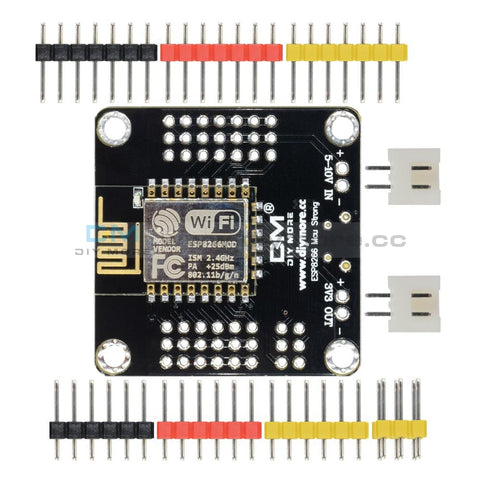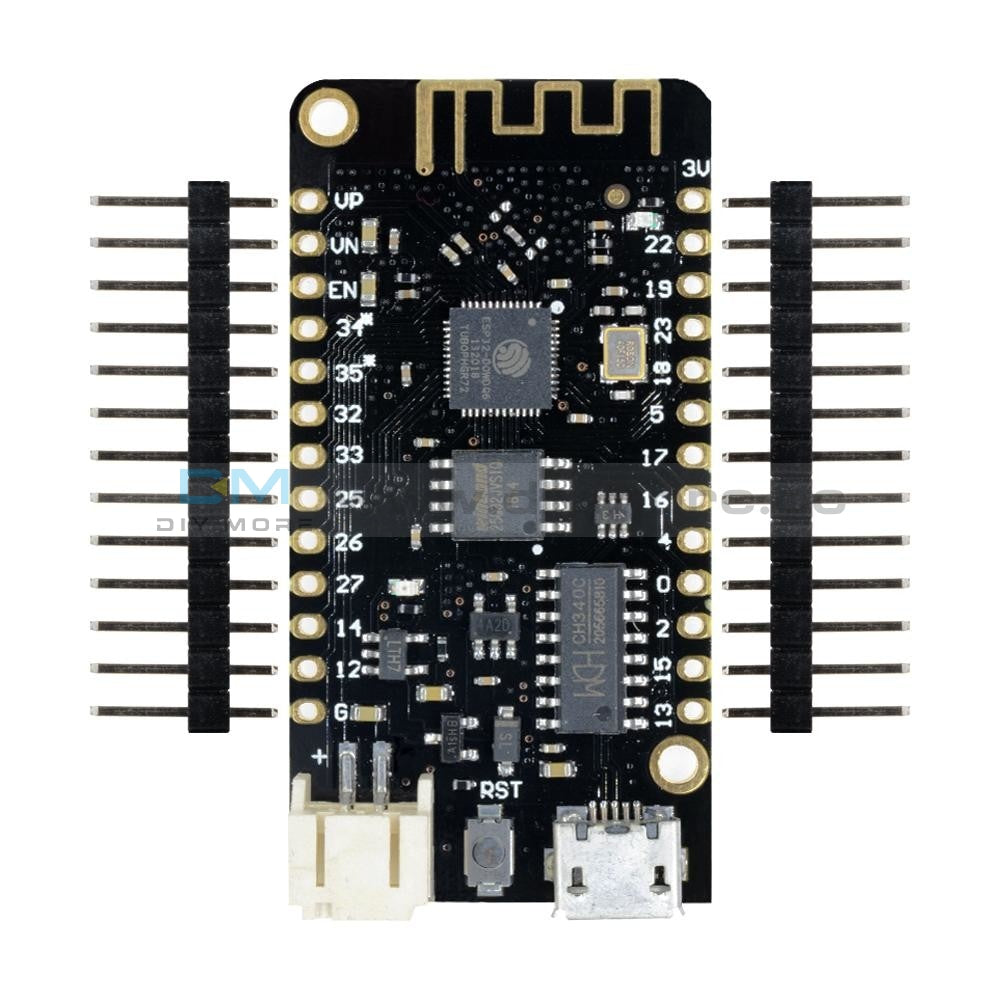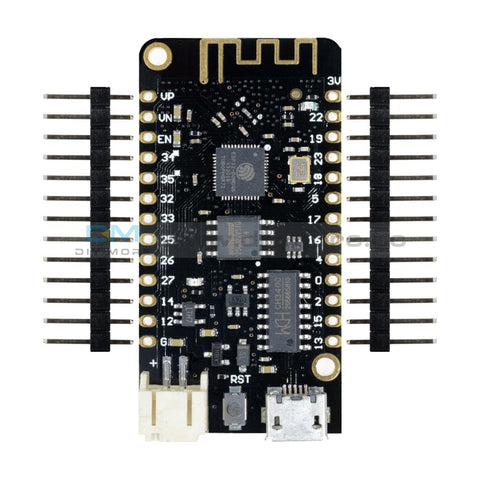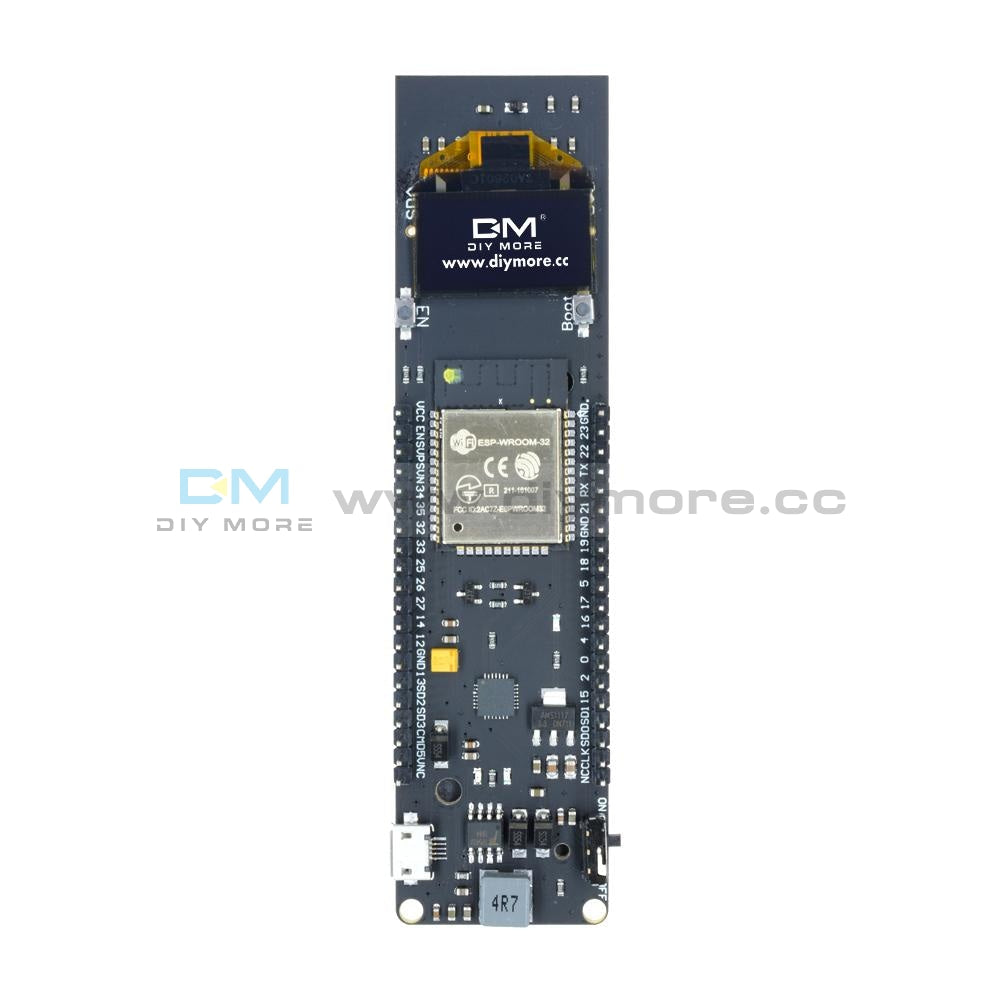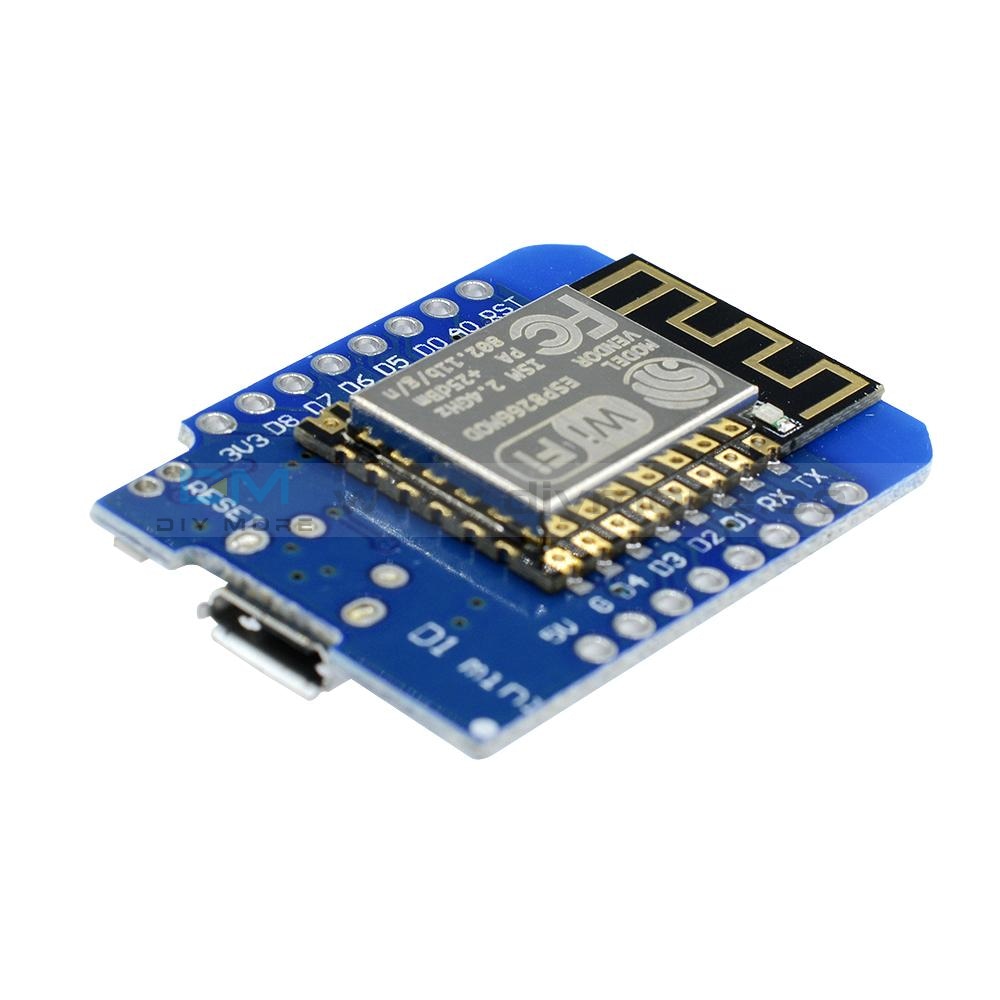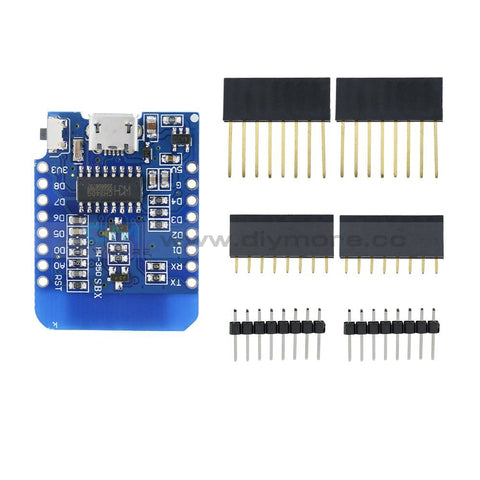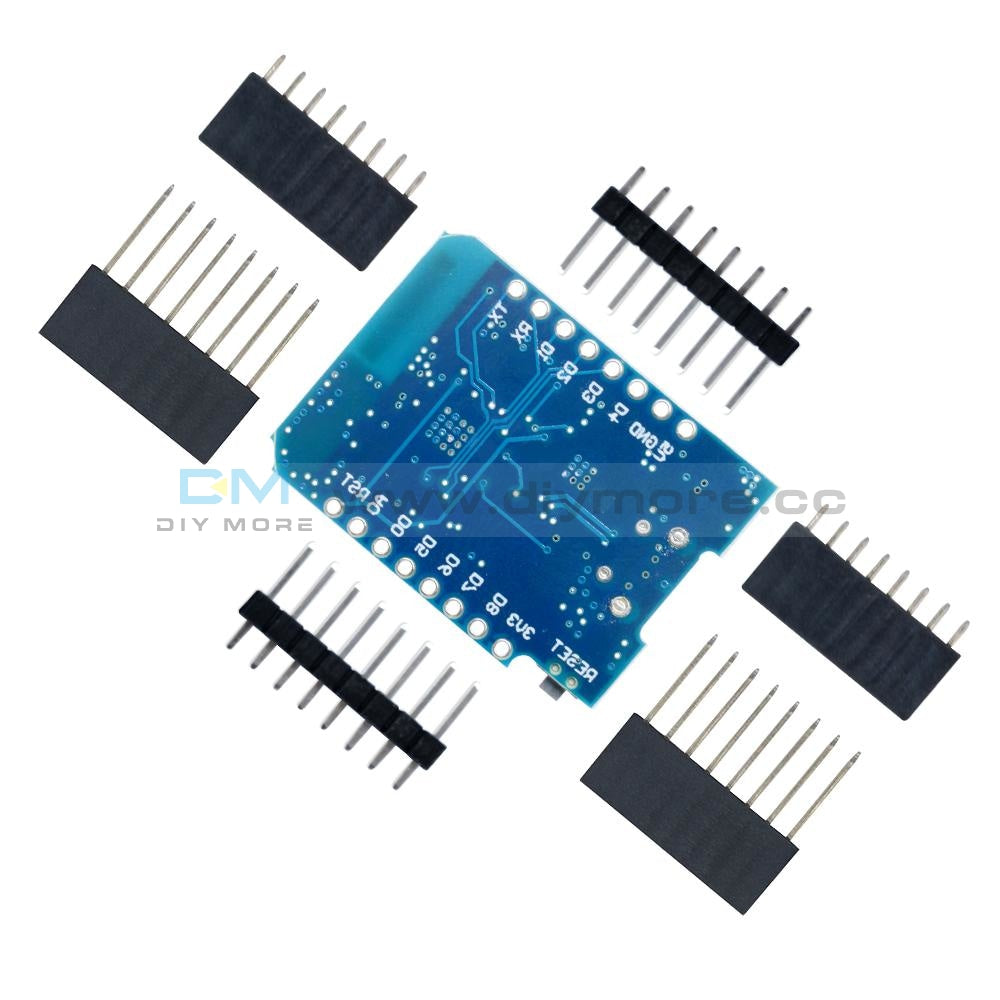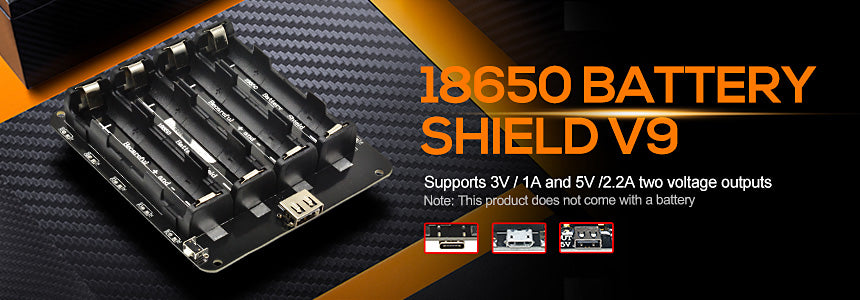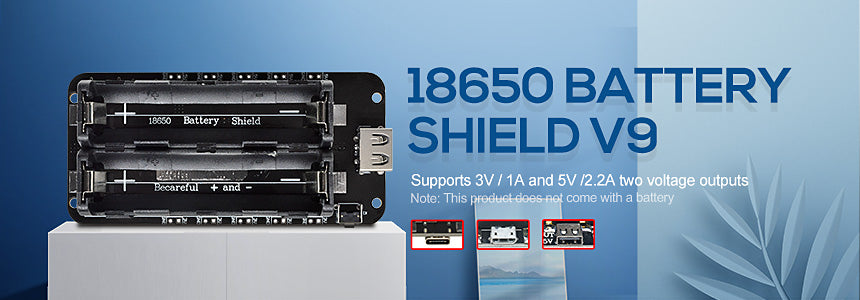L293D Motor Shield Board Wireless Wifi Esp8266 Esp 12E Node MCU Development Kit NodeMCU Rc Toy Remote Control IoT Smart Car
L293D Motor Shield Board Wireless Wifi Esp8266 Esp 12E Node MCU Development Kit NodeMCU Rc Toy Remote Control IoT Smart Car
SKU:ZH0138
Regular price
$9.99 USD
![]()
- guaranteeQuality checked
- Special gift cardsSpecial gift cards
- Free return Within 60 days
- Consultancy86-0755-85201155
- Based on ESP-12E development kit, it can facilitate the development of WiFi Smart car, free to send Android phone source.
- ESP12 DEV KIT development board expansion module;
- lead ESP12 DEV KIT All-function pins: SPI, UART, GPIO, AI and 3.3V power connector;
- expand two-way motor-driven, two-way direct drive motor;
- onboard power switch;
- Motor power range: 4.5V ~ 36V;
- Control power range: 4.5V ~ 9V;
- Motor power, control power separation; In the experiment, by short-circuiting block the merger, the VIN and VM short, while power supply to the motor and the control board.
- Precautions
- When l insert ESP-12E module, please note the direction consistent with an expansion board antenna;
- use of short modules that can simultaneously control board and motor.

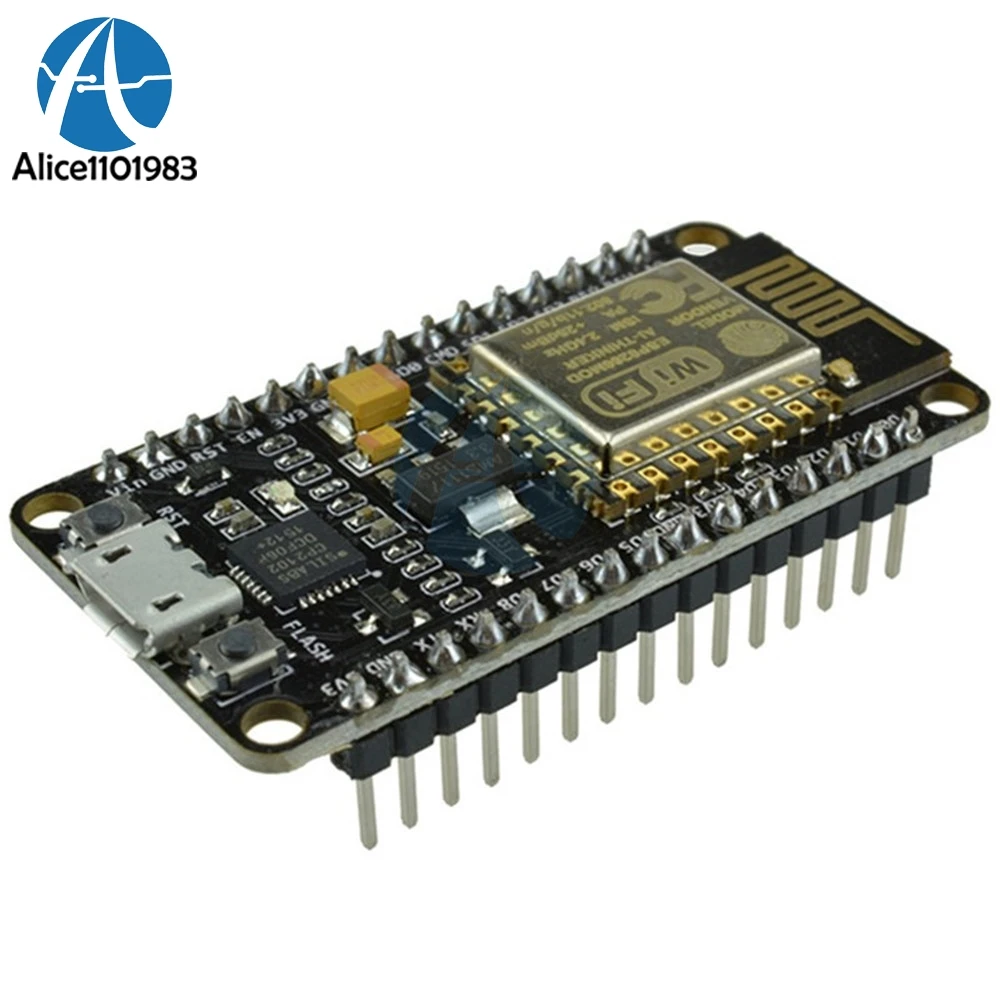



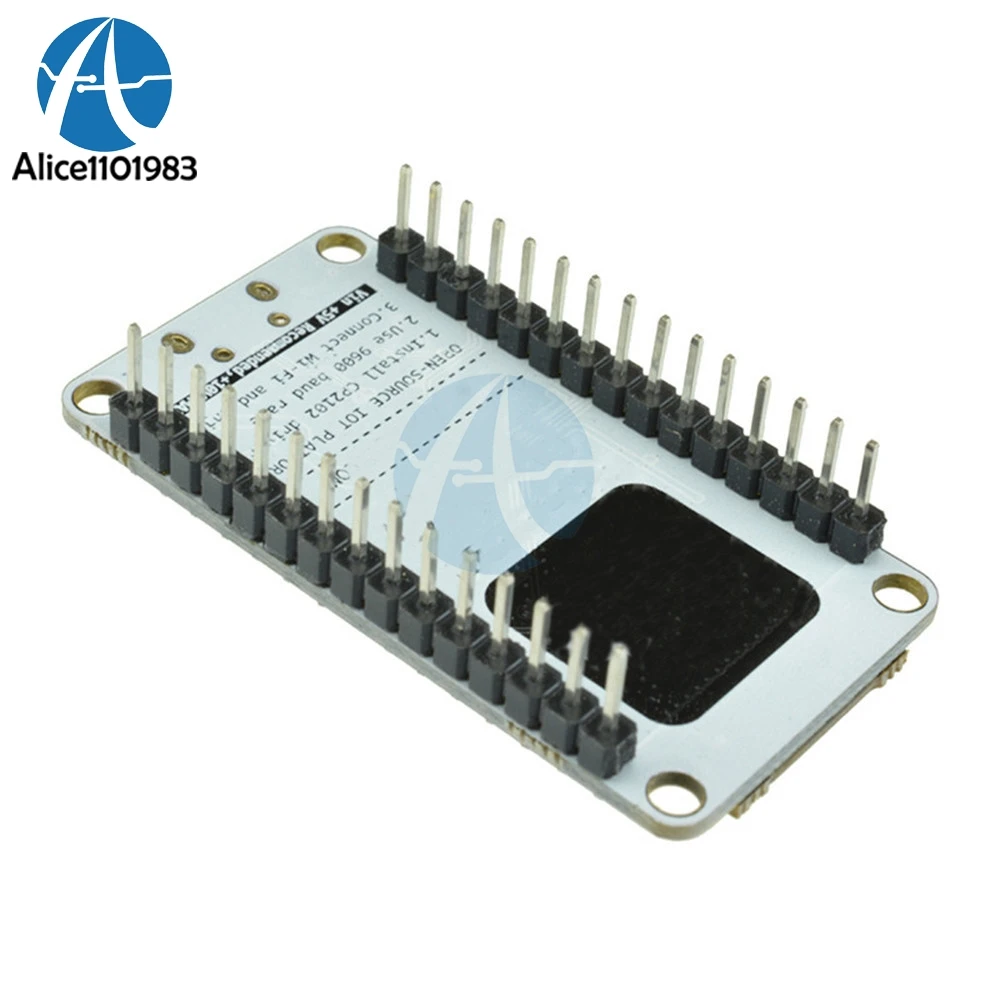
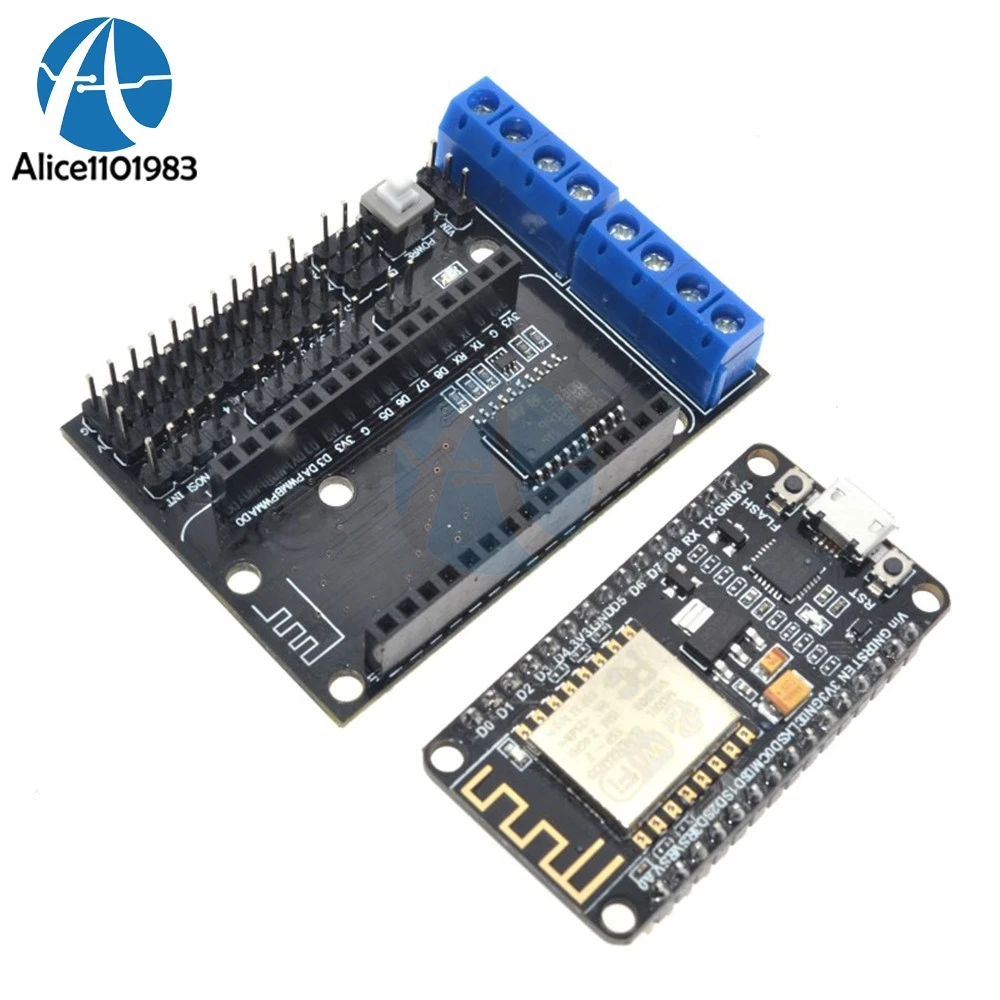

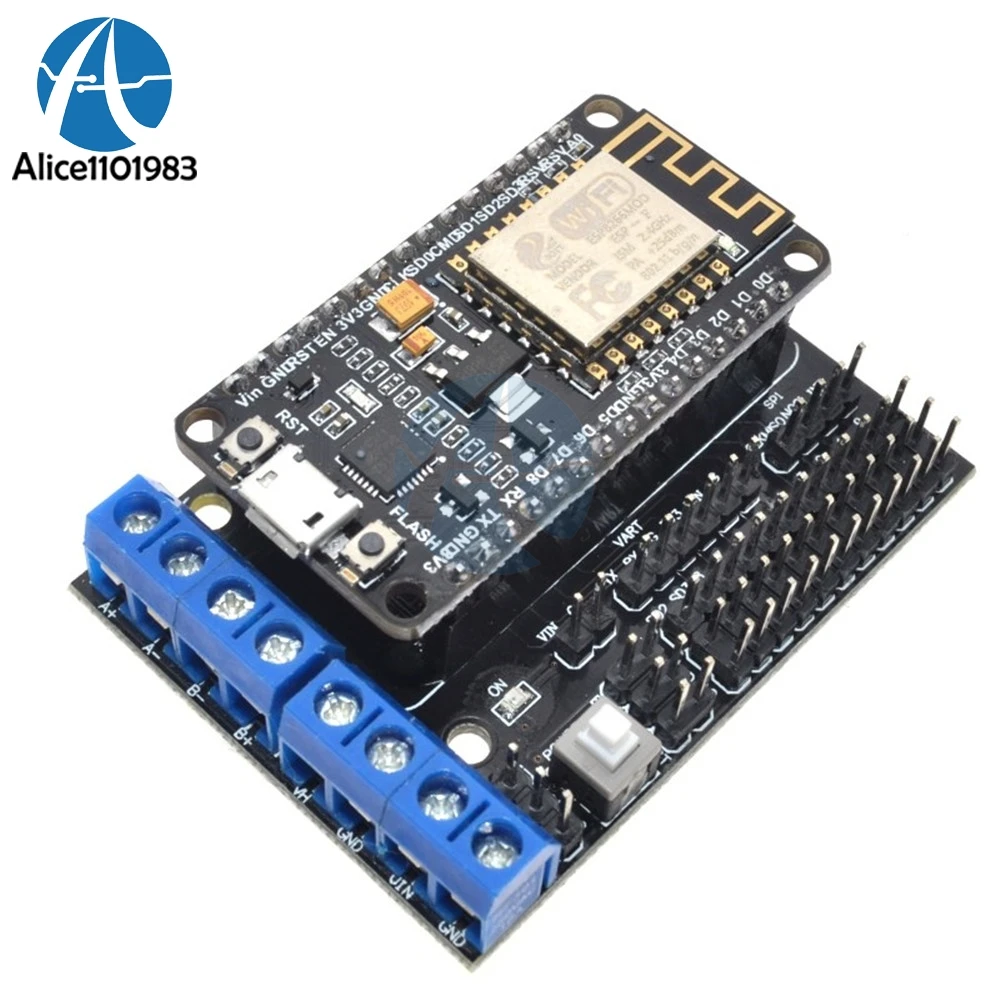
Purchasing & Delivery
Before you make your purchase, it’s helpful to know the measurements of the area you plan to place the furniture. You should also measure any doorways and hallways through which the furniture will pass to get to its final destination.Picking up at the store
Shopify Shop requires that all products are properly inspected BEFORE you take it home to insure there are no surprises. Our team is happy to open all packages and will assist in the inspection process. We will then reseal packages for safe transport. We encourage all customers to bring furniture pads or blankets to protect the items during transport as well as rope or tie downs. Shopify Shop will not be responsible for damage that occurs after leaving the store or during transit. It is the purchaser’s responsibility to make sure the correct items are picked up and in good condition.Delivery
Customers are able to pick the next available delivery day that best fits their schedule. However, to route stops as efficiently as possible, Shopify Shop will provide the time frame. Customers will not be able to choose a time. You will be notified in advance of your scheduled time frame. Please make sure that a responsible adult (18 years or older) will be home at that time.In preparation for your delivery, please remove existing furniture, pictures, mirrors, accessories, etc. to prevent damages. Also insure that the area where you would like your furniture placed is clear of any old furniture and any other items that may obstruct the passageway of the delivery team. Shopify Shop will deliver, assemble, and set-up your new furniture purchase and remove all packing materials from your home. Our delivery crews are not permitted to move your existing furniture or other household items. Delivery personnel will attempt to deliver the purchased items in a safe and controlled manner but will not attempt to place furniture if they feel it will result in damage to the product or your home. Delivery personnel are unable to remove doors, hoist furniture or carry furniture up more than 3 flights of stairs. An elevator must be available for deliveries to the 4th floor and above.
Other Customers also buy:
-
Translation missing: en.products.product.regular_price $9.99 USD{"id":4419943923783,"title":"L293D Motor Shield Board Wireless Wifi Esp8266 Esp 12E Node MCU Development Kit NodeMCU Rc Toy Remote Control IoT Smart Car","handle":"l293d-motor-shield-board-wireless-wifi-esp8266-esp-12e-node-mcu-development-kit-nodemcu-rc-toy-remote-control-iot-smart-car","description":"\u003cdiv\u003e\n\u003cwidget data-widget-type=\"customText\" id=\"33684419\" title=\"Head\" type=\"custom\"\u003e\u003c\/widget\u003e \r \u003cp\u003e \u003c\/p\u003e \r \u003cp\u003e \u003c\/p\u003e \r \u003cp\u003e \u003c\/p\u003e \r \u003cul\u003e \r \u003cli\u003e \u003cspan style=\"font-size: 16.0px;font-family: trebuchet ms;\"\u003eBased on ESP-12E development kit, it can facilitate the development of WiFi Smart car, free to send Android phone source.\u003c\/span\u003e \u003c\/li\u003e \r \u003cli\u003e \u003cspan style=\"font-size: 16.0px;font-family: trebuchet ms;\"\u003eESP12 DEV KIT development board expansion module;\u003c\/span\u003e \u003c\/li\u003e \r \u003cli\u003e \u003cspan style=\"font-size: 16.0px;font-family: trebuchet ms;\"\u003elead ESP12 DEV KIT All-function pins: SPI, UART, GPIO, AI and 3.3V power connector;\u003c\/span\u003e \u003c\/li\u003e \r \u003cli\u003e \u003cspan style=\"font-size: 16.0px;font-family: trebuchet ms;\"\u003eexpand two-way motor-driven, two-way direct drive motor;\u003c\/span\u003e \u003c\/li\u003e \r \u003cli\u003e \u003cspan style=\"font-size: 16.0px;font-family: trebuchet ms;\"\u003eonboard power switch;\u003c\/span\u003e \u003c\/li\u003e \r \u003cli\u003e \u003cspan style=\"font-size: 16.0px;font-family: trebuchet ms;\"\u003eMotor power range: 4.5V ~ 36V;\u003c\/span\u003e \u003c\/li\u003e \r \u003cli\u003e \u003cspan style=\"font-size: 16.0px;font-family: trebuchet ms;\"\u003eControl power range: 4.5V ~ 9V;\u003c\/span\u003e \u003c\/li\u003e \r \u003cli\u003e \u003cspan style=\"font-size: 16.0px;font-family: trebuchet ms;\"\u003eMotor power, control power separation; In the experiment, by short-circuiting block the merger, the VIN and VM short, while power supply to the motor and the control board.\u003c\/span\u003e \u003c\/li\u003e \r \u003cli\u003e \u003cspan style=\"font-size: 16.0px;font-family: trebuchet ms;\"\u003ePrecautions\u003c\/span\u003e \u003c\/li\u003e \r \u003cli\u003e \u003cspan style=\"font-size: 16.0px;font-family: trebuchet ms;\"\u003eWhen l insert ESP-12E module, please note the direction consistent with an expansion board antenna;\u003c\/span\u003e \u003c\/li\u003e \r \u003cli\u003e \u003cspan style=\"font-size: 16.0px;font-family: trebuchet ms;\"\u003euse of short modules that can simultaneously control board and motor.\u003c\/span\u003e \u003c\/li\u003e \r \u003c\/ul\u003e \r \u003cp\u003e \u003c\/p\u003e \r \u003cp\u003e \u003c\/p\u003e \r \u003cp\u003e \u003c\/p\u003e \r \u003cp\u003e \u003cimg src=\"https:\/\/ae01.alicdn.com\/kf\/HTB1YNpNkx1YBuNjy1zcq6zNcXXa3.jpg\" width=\"1000\"\u003e\u003c\/p\u003e \r \u003cp\u003e \u003cimg src=\"https:\/\/ae01.alicdn.com\/kf\/HTB1FIY.cRjTBKNjSZFuq6z0HFXax.jpg\" width=\"1000\"\u003e\u003c\/p\u003e \r \u003cp\u003e \u003cimg src=\"https:\/\/ae01.alicdn.com\/kf\/HTB11MNfkrGYBuNjy0Foq6AiBFXaz.jpg\" width=\"1000\"\u003e\u003c\/p\u003e \r \u003cp\u003e \u003cimg src=\"https:\/\/ae01.alicdn.com\/kf\/HTB185jPcLuSBuNkHFqDq6xfhVXaA.jpg\" width=\"1000\"\u003e\u003c\/p\u003e \r \u003cp\u003e \u003cimg src=\"https:\/\/ae01.alicdn.com\/kf\/HTB1wupRkuySBuNjy1zdq6xPxFXaJ.jpg\" width=\"1000\"\u003e\u003c\/p\u003e \r \u003cp\u003e \u003cimg src=\"https:\/\/ae01.alicdn.com\/kf\/HTB1DWg.kgaTBuNjSszfq6xgfpXa2.jpg\" width=\"1000\"\u003e\u003c\/p\u003e \r \u003cp\u003e \u003cimg src=\"https:\/\/ae01.alicdn.com\/kf\/HTB1I4BfkrGYBuNjy0Foq6AiBFXaJ.jpg\" width=\"1000\"\u003e\u003c\/p\u003e \r \u003cp\u003e \u003cimg src=\"https:\/\/ae01.alicdn.com\/kf\/HTB1GARVkr5YBuNjSspoq6zeNFXa8.jpg\" width=\"1000\"\u003e\u003c\/p\u003e \r \u003cp\u003e \u003cimg src=\"https:\/\/ae01.alicdn.com\/kf\/HTB1.K.4kXmWBuNjSspdq6zugXXaj.jpg\" width=\"1000\"\u003e\u003c\/p\u003e \u003cscript\u003ewindow.adminAccountId=227552571;\u003c\/script\u003e \u003c\/div\u003e","published_at":"2019-12-27T16:34:21+08:00","created_at":"2019-12-27T16:34:32+08:00","vendor":"diymore","type":"Integrated Circuits","tags":[],"price":999,"price_min":999,"price_max":999,"available":true,"price_varies":false,"compare_at_price":null,"compare_at_price_min":0,"compare_at_price_max":0,"compare_at_price_varies":false,"variants":[{"id":31582633328711,"title":"Default Title","option1":"Default Title","option2":null,"option3":null,"sku":"ZH0138","requires_shipping":true,"taxable":true,"featured_image":null,"available":true,"name":"L293D Motor Shield Board Wireless Wifi Esp8266 Esp 12E Node MCU Development Kit NodeMCU Rc Toy Remote Control IoT Smart Car","public_title":null,"options":["Default Title"],"price":999,"weight":0,"compare_at_price":null,"inventory_management":null,"barcode":"","requires_selling_plan":false,"selling_plan_allocations":[]}],"images":["\/\/www.diymore.cc\/cdn\/shop\/products\/L293D-Motor-Shield-Board-Wireless-Wifi-Esp8266-Esp-12E-Node-MCU-Development-Kit-NodeMCU-Rc-Toy_410.jpg?v=1588698342","\/\/www.diymore.cc\/cdn\/shop\/products\/L293D-Motor-Shield-Board-Wireless-Wifi-Esp8266-Esp-12E-Node-MCU-Development-Kit-NodeMCU-Rc-Toy_f39da38f-e84f-4071-8758-cbe8c7fed26e_480.jpg?v=1588698342","\/\/www.diymore.cc\/cdn\/shop\/products\/L293D-Motor-Shield-Board-Wireless-Wifi-Esp8266-Esp-12E-Node-MCU-Development-Kit-NodeMCU-Rc-Toy_520afb30-ad65-4017-8643-c2af5448b51f_243.jpg?v=1588698342","\/\/www.diymore.cc\/cdn\/shop\/products\/L293D-Motor-Shield-Board-Wireless-Wifi-Esp8266-Esp-12E-Node-MCU-Development-Kit-NodeMCU-Rc-Toy_1ee54612-6130-4c1a-a993-34c435599701_500.jpg?v=1588698342","\/\/www.diymore.cc\/cdn\/shop\/products\/L293D-Motor-Shield-Board-Wireless-Wifi-Esp8266-Esp-12E-Node-MCU-Development-Kit-NodeMCU-Rc-Toy_3b41e076-1de1-4a28-809f-369a20b969d7_435.jpg?v=1588698342","\/\/www.diymore.cc\/cdn\/shop\/products\/L293D-Motor-Shield-Board-Wireless-Wifi-Esp8266-Esp-12E-Node-MCU-Development-Kit-NodeMCU-Rc-Toy_bf475e25-2399-4fb9-827a-6856d88f779a_906.jpg?v=1588698342"],"featured_image":"\/\/www.diymore.cc\/cdn\/shop\/products\/L293D-Motor-Shield-Board-Wireless-Wifi-Esp8266-Esp-12E-Node-MCU-Development-Kit-NodeMCU-Rc-Toy_410.jpg?v=1588698342","options":["Title"],"media":[{"alt":"L293D Motor Shield Board Wireless Wifi Esp8266 Esp 12E Node Mcu Development Kit Nodemcu Rc Toy","id":6682345766983,"position":1,"preview_image":{"aspect_ratio":1.0,"height":1000,"width":1000,"src":"\/\/www.diymore.cc\/cdn\/shop\/products\/L293D-Motor-Shield-Board-Wireless-Wifi-Esp8266-Esp-12E-Node-MCU-Development-Kit-NodeMCU-Rc-Toy_410.jpg?v=1588698342"},"aspect_ratio":1.0,"height":1000,"media_type":"image","src":"\/\/www.diymore.cc\/cdn\/shop\/products\/L293D-Motor-Shield-Board-Wireless-Wifi-Esp8266-Esp-12E-Node-MCU-Development-Kit-NodeMCU-Rc-Toy_410.jpg?v=1588698342","width":1000},{"alt":"L293D Motor Shield Board Wireless Wifi Esp8266 Esp 12E Node Mcu Development Kit Nodemcu Rc Toy","id":6682345865287,"position":2,"preview_image":{"aspect_ratio":1.0,"height":1000,"width":1000,"src":"\/\/www.diymore.cc\/cdn\/shop\/products\/L293D-Motor-Shield-Board-Wireless-Wifi-Esp8266-Esp-12E-Node-MCU-Development-Kit-NodeMCU-Rc-Toy_f39da38f-e84f-4071-8758-cbe8c7fed26e_480.jpg?v=1588698342"},"aspect_ratio":1.0,"height":1000,"media_type":"image","src":"\/\/www.diymore.cc\/cdn\/shop\/products\/L293D-Motor-Shield-Board-Wireless-Wifi-Esp8266-Esp-12E-Node-MCU-Development-Kit-NodeMCU-Rc-Toy_f39da38f-e84f-4071-8758-cbe8c7fed26e_480.jpg?v=1588698342","width":1000},{"alt":"L293D Motor Shield Board Wireless Wifi Esp8266 Esp 12E Node Mcu Development Kit Nodemcu Rc Toy","id":6682346094663,"position":3,"preview_image":{"aspect_ratio":1.0,"height":1000,"width":1000,"src":"\/\/www.diymore.cc\/cdn\/shop\/products\/L293D-Motor-Shield-Board-Wireless-Wifi-Esp8266-Esp-12E-Node-MCU-Development-Kit-NodeMCU-Rc-Toy_520afb30-ad65-4017-8643-c2af5448b51f_243.jpg?v=1588698342"},"aspect_ratio":1.0,"height":1000,"media_type":"image","src":"\/\/www.diymore.cc\/cdn\/shop\/products\/L293D-Motor-Shield-Board-Wireless-Wifi-Esp8266-Esp-12E-Node-MCU-Development-Kit-NodeMCU-Rc-Toy_520afb30-ad65-4017-8643-c2af5448b51f_243.jpg?v=1588698342","width":1000},{"alt":"L293D Motor Shield Board Wireless Wifi Esp8266 Esp 12E Node Mcu Development Kit Nodemcu Rc Toy","id":6682346913863,"position":4,"preview_image":{"aspect_ratio":1.0,"height":1000,"width":1000,"src":"\/\/www.diymore.cc\/cdn\/shop\/products\/L293D-Motor-Shield-Board-Wireless-Wifi-Esp8266-Esp-12E-Node-MCU-Development-Kit-NodeMCU-Rc-Toy_1ee54612-6130-4c1a-a993-34c435599701_500.jpg?v=1588698342"},"aspect_ratio":1.0,"height":1000,"media_type":"image","src":"\/\/www.diymore.cc\/cdn\/shop\/products\/L293D-Motor-Shield-Board-Wireless-Wifi-Esp8266-Esp-12E-Node-MCU-Development-Kit-NodeMCU-Rc-Toy_1ee54612-6130-4c1a-a993-34c435599701_500.jpg?v=1588698342","width":1000},{"alt":"L293D Motor Shield Board Wireless Wifi Esp8266 Esp 12E Node Mcu Development Kit Nodemcu Rc Toy","id":6682347274311,"position":5,"preview_image":{"aspect_ratio":1.0,"height":1000,"width":1000,"src":"\/\/www.diymore.cc\/cdn\/shop\/products\/L293D-Motor-Shield-Board-Wireless-Wifi-Esp8266-Esp-12E-Node-MCU-Development-Kit-NodeMCU-Rc-Toy_3b41e076-1de1-4a28-809f-369a20b969d7_435.jpg?v=1588698342"},"aspect_ratio":1.0,"height":1000,"media_type":"image","src":"\/\/www.diymore.cc\/cdn\/shop\/products\/L293D-Motor-Shield-Board-Wireless-Wifi-Esp8266-Esp-12E-Node-MCU-Development-Kit-NodeMCU-Rc-Toy_3b41e076-1de1-4a28-809f-369a20b969d7_435.jpg?v=1588698342","width":1000},{"alt":"L293D Motor Shield Board Wireless Wifi Esp8266 Esp 12E Node Mcu Development Kit Nodemcu Rc Toy","id":6682347601991,"position":6,"preview_image":{"aspect_ratio":1.0,"height":1000,"width":1000,"src":"\/\/www.diymore.cc\/cdn\/shop\/products\/L293D-Motor-Shield-Board-Wireless-Wifi-Esp8266-Esp-12E-Node-MCU-Development-Kit-NodeMCU-Rc-Toy_bf475e25-2399-4fb9-827a-6856d88f779a_906.jpg?v=1588698342"},"aspect_ratio":1.0,"height":1000,"media_type":"image","src":"\/\/www.diymore.cc\/cdn\/shop\/products\/L293D-Motor-Shield-Board-Wireless-Wifi-Esp8266-Esp-12E-Node-MCU-Development-Kit-NodeMCU-Rc-Toy_bf475e25-2399-4fb9-827a-6856d88f779a_906.jpg?v=1588698342","width":1000}],"requires_selling_plan":false,"selling_plan_groups":[],"content":"\u003cdiv\u003e\n\u003cwidget data-widget-type=\"customText\" id=\"33684419\" title=\"Head\" type=\"custom\"\u003e\u003c\/widget\u003e \r \u003cp\u003e \u003c\/p\u003e \r \u003cp\u003e \u003c\/p\u003e \r \u003cp\u003e \u003c\/p\u003e \r \u003cul\u003e \r \u003cli\u003e \u003cspan style=\"font-size: 16.0px;font-family: trebuchet ms;\"\u003eBased on ESP-12E development kit, it can facilitate the development of WiFi Smart car, free to send Android phone source.\u003c\/span\u003e \u003c\/li\u003e \r \u003cli\u003e \u003cspan style=\"font-size: 16.0px;font-family: trebuchet ms;\"\u003eESP12 DEV KIT development board expansion module;\u003c\/span\u003e \u003c\/li\u003e \r \u003cli\u003e \u003cspan style=\"font-size: 16.0px;font-family: trebuchet ms;\"\u003elead ESP12 DEV KIT All-function pins: SPI, UART, GPIO, AI and 3.3V power connector;\u003c\/span\u003e \u003c\/li\u003e \r \u003cli\u003e \u003cspan style=\"font-size: 16.0px;font-family: trebuchet ms;\"\u003eexpand two-way motor-driven, two-way direct drive motor;\u003c\/span\u003e \u003c\/li\u003e \r \u003cli\u003e \u003cspan style=\"font-size: 16.0px;font-family: trebuchet ms;\"\u003eonboard power switch;\u003c\/span\u003e \u003c\/li\u003e \r \u003cli\u003e \u003cspan style=\"font-size: 16.0px;font-family: trebuchet ms;\"\u003eMotor power range: 4.5V ~ 36V;\u003c\/span\u003e \u003c\/li\u003e \r \u003cli\u003e \u003cspan style=\"font-size: 16.0px;font-family: trebuchet ms;\"\u003eControl power range: 4.5V ~ 9V;\u003c\/span\u003e \u003c\/li\u003e \r \u003cli\u003e \u003cspan style=\"font-size: 16.0px;font-family: trebuchet ms;\"\u003eMotor power, control power separation; In the experiment, by short-circuiting block the merger, the VIN and VM short, while power supply to the motor and the control board.\u003c\/span\u003e \u003c\/li\u003e \r \u003cli\u003e \u003cspan style=\"font-size: 16.0px;font-family: trebuchet ms;\"\u003ePrecautions\u003c\/span\u003e \u003c\/li\u003e \r \u003cli\u003e \u003cspan style=\"font-size: 16.0px;font-family: trebuchet ms;\"\u003eWhen l insert ESP-12E module, please note the direction consistent with an expansion board antenna;\u003c\/span\u003e \u003c\/li\u003e \r \u003cli\u003e \u003cspan style=\"font-size: 16.0px;font-family: trebuchet ms;\"\u003euse of short modules that can simultaneously control board and motor.\u003c\/span\u003e \u003c\/li\u003e \r \u003c\/ul\u003e \r \u003cp\u003e \u003c\/p\u003e \r \u003cp\u003e \u003c\/p\u003e \r \u003cp\u003e \u003c\/p\u003e \r \u003cp\u003e \u003cimg src=\"https:\/\/ae01.alicdn.com\/kf\/HTB1YNpNkx1YBuNjy1zcq6zNcXXa3.jpg\" width=\"1000\"\u003e\u003c\/p\u003e \r \u003cp\u003e \u003cimg src=\"https:\/\/ae01.alicdn.com\/kf\/HTB1FIY.cRjTBKNjSZFuq6z0HFXax.jpg\" width=\"1000\"\u003e\u003c\/p\u003e \r \u003cp\u003e \u003cimg src=\"https:\/\/ae01.alicdn.com\/kf\/HTB11MNfkrGYBuNjy0Foq6AiBFXaz.jpg\" width=\"1000\"\u003e\u003c\/p\u003e \r \u003cp\u003e \u003cimg src=\"https:\/\/ae01.alicdn.com\/kf\/HTB185jPcLuSBuNkHFqDq6xfhVXaA.jpg\" width=\"1000\"\u003e\u003c\/p\u003e \r \u003cp\u003e \u003cimg src=\"https:\/\/ae01.alicdn.com\/kf\/HTB1wupRkuySBuNjy1zdq6xPxFXaJ.jpg\" width=\"1000\"\u003e\u003c\/p\u003e \r \u003cp\u003e \u003cimg src=\"https:\/\/ae01.alicdn.com\/kf\/HTB1DWg.kgaTBuNjSszfq6xgfpXa2.jpg\" width=\"1000\"\u003e\u003c\/p\u003e \r \u003cp\u003e \u003cimg src=\"https:\/\/ae01.alicdn.com\/kf\/HTB1I4BfkrGYBuNjy0Foq6AiBFXaJ.jpg\" width=\"1000\"\u003e\u003c\/p\u003e \r \u003cp\u003e \u003cimg src=\"https:\/\/ae01.alicdn.com\/kf\/HTB1GARVkr5YBuNjSspoq6zeNFXa8.jpg\" width=\"1000\"\u003e\u003c\/p\u003e \r \u003cp\u003e \u003cimg src=\"https:\/\/ae01.alicdn.com\/kf\/HTB1.K.4kXmWBuNjSspdq6zugXXaj.jpg\" width=\"1000\"\u003e\u003c\/p\u003e \u003cscript\u003ewindow.adminAccountId=227552571;\u003c\/script\u003e \u003c\/div\u003e"}
-
Translation missing: en.products.product.regular_price $8.99 USD{"id":4419943923783,"title":"L293D Motor Shield Board Wireless Wifi Esp8266 Esp 12E Node MCU Development Kit NodeMCU Rc Toy Remote Control IoT Smart Car","handle":"l293d-motor-shield-board-wireless-wifi-esp8266-esp-12e-node-mcu-development-kit-nodemcu-rc-toy-remote-control-iot-smart-car","description":"\u003cdiv\u003e\n\u003cwidget data-widget-type=\"customText\" id=\"33684419\" title=\"Head\" type=\"custom\"\u003e\u003c\/widget\u003e \r \u003cp\u003e \u003c\/p\u003e \r \u003cp\u003e \u003c\/p\u003e \r \u003cp\u003e \u003c\/p\u003e \r \u003cul\u003e \r \u003cli\u003e \u003cspan style=\"font-size: 16.0px;font-family: trebuchet ms;\"\u003eBased on ESP-12E development kit, it can facilitate the development of WiFi Smart car, free to send Android phone source.\u003c\/span\u003e \u003c\/li\u003e \r \u003cli\u003e \u003cspan style=\"font-size: 16.0px;font-family: trebuchet ms;\"\u003eESP12 DEV KIT development board expansion module;\u003c\/span\u003e \u003c\/li\u003e \r \u003cli\u003e \u003cspan style=\"font-size: 16.0px;font-family: trebuchet ms;\"\u003elead ESP12 DEV KIT All-function pins: SPI, UART, GPIO, AI and 3.3V power connector;\u003c\/span\u003e \u003c\/li\u003e \r \u003cli\u003e \u003cspan style=\"font-size: 16.0px;font-family: trebuchet ms;\"\u003eexpand two-way motor-driven, two-way direct drive motor;\u003c\/span\u003e \u003c\/li\u003e \r \u003cli\u003e \u003cspan style=\"font-size: 16.0px;font-family: trebuchet ms;\"\u003eonboard power switch;\u003c\/span\u003e \u003c\/li\u003e \r \u003cli\u003e \u003cspan style=\"font-size: 16.0px;font-family: trebuchet ms;\"\u003eMotor power range: 4.5V ~ 36V;\u003c\/span\u003e \u003c\/li\u003e \r \u003cli\u003e \u003cspan style=\"font-size: 16.0px;font-family: trebuchet ms;\"\u003eControl power range: 4.5V ~ 9V;\u003c\/span\u003e \u003c\/li\u003e \r \u003cli\u003e \u003cspan style=\"font-size: 16.0px;font-family: trebuchet ms;\"\u003eMotor power, control power separation; In the experiment, by short-circuiting block the merger, the VIN and VM short, while power supply to the motor and the control board.\u003c\/span\u003e \u003c\/li\u003e \r \u003cli\u003e \u003cspan style=\"font-size: 16.0px;font-family: trebuchet ms;\"\u003ePrecautions\u003c\/span\u003e \u003c\/li\u003e \r \u003cli\u003e \u003cspan style=\"font-size: 16.0px;font-family: trebuchet ms;\"\u003eWhen l insert ESP-12E module, please note the direction consistent with an expansion board antenna;\u003c\/span\u003e \u003c\/li\u003e \r \u003cli\u003e \u003cspan style=\"font-size: 16.0px;font-family: trebuchet ms;\"\u003euse of short modules that can simultaneously control board and motor.\u003c\/span\u003e \u003c\/li\u003e \r \u003c\/ul\u003e \r \u003cp\u003e \u003c\/p\u003e \r \u003cp\u003e \u003c\/p\u003e \r \u003cp\u003e \u003c\/p\u003e \r \u003cp\u003e \u003cimg src=\"https:\/\/ae01.alicdn.com\/kf\/HTB1YNpNkx1YBuNjy1zcq6zNcXXa3.jpg\" width=\"1000\"\u003e\u003c\/p\u003e \r \u003cp\u003e \u003cimg src=\"https:\/\/ae01.alicdn.com\/kf\/HTB1FIY.cRjTBKNjSZFuq6z0HFXax.jpg\" width=\"1000\"\u003e\u003c\/p\u003e \r \u003cp\u003e \u003cimg src=\"https:\/\/ae01.alicdn.com\/kf\/HTB11MNfkrGYBuNjy0Foq6AiBFXaz.jpg\" width=\"1000\"\u003e\u003c\/p\u003e \r \u003cp\u003e \u003cimg src=\"https:\/\/ae01.alicdn.com\/kf\/HTB185jPcLuSBuNkHFqDq6xfhVXaA.jpg\" width=\"1000\"\u003e\u003c\/p\u003e \r \u003cp\u003e \u003cimg src=\"https:\/\/ae01.alicdn.com\/kf\/HTB1wupRkuySBuNjy1zdq6xPxFXaJ.jpg\" width=\"1000\"\u003e\u003c\/p\u003e \r \u003cp\u003e \u003cimg src=\"https:\/\/ae01.alicdn.com\/kf\/HTB1DWg.kgaTBuNjSszfq6xgfpXa2.jpg\" width=\"1000\"\u003e\u003c\/p\u003e \r \u003cp\u003e \u003cimg src=\"https:\/\/ae01.alicdn.com\/kf\/HTB1I4BfkrGYBuNjy0Foq6AiBFXaJ.jpg\" width=\"1000\"\u003e\u003c\/p\u003e \r \u003cp\u003e \u003cimg src=\"https:\/\/ae01.alicdn.com\/kf\/HTB1GARVkr5YBuNjSspoq6zeNFXa8.jpg\" width=\"1000\"\u003e\u003c\/p\u003e \r \u003cp\u003e \u003cimg src=\"https:\/\/ae01.alicdn.com\/kf\/HTB1.K.4kXmWBuNjSspdq6zugXXaj.jpg\" width=\"1000\"\u003e\u003c\/p\u003e \u003cscript\u003ewindow.adminAccountId=227552571;\u003c\/script\u003e \u003c\/div\u003e","published_at":"2019-12-27T16:34:21+08:00","created_at":"2019-12-27T16:34:32+08:00","vendor":"diymore","type":"Integrated Circuits","tags":[],"price":999,"price_min":999,"price_max":999,"available":true,"price_varies":false,"compare_at_price":null,"compare_at_price_min":0,"compare_at_price_max":0,"compare_at_price_varies":false,"variants":[{"id":31582633328711,"title":"Default Title","option1":"Default Title","option2":null,"option3":null,"sku":"ZH0138","requires_shipping":true,"taxable":true,"featured_image":null,"available":true,"name":"L293D Motor Shield Board Wireless Wifi Esp8266 Esp 12E Node MCU Development Kit NodeMCU Rc Toy Remote Control IoT Smart Car","public_title":null,"options":["Default Title"],"price":999,"weight":0,"compare_at_price":null,"inventory_management":null,"barcode":"","requires_selling_plan":false,"selling_plan_allocations":[]}],"images":["\/\/www.diymore.cc\/cdn\/shop\/products\/L293D-Motor-Shield-Board-Wireless-Wifi-Esp8266-Esp-12E-Node-MCU-Development-Kit-NodeMCU-Rc-Toy_410.jpg?v=1588698342","\/\/www.diymore.cc\/cdn\/shop\/products\/L293D-Motor-Shield-Board-Wireless-Wifi-Esp8266-Esp-12E-Node-MCU-Development-Kit-NodeMCU-Rc-Toy_f39da38f-e84f-4071-8758-cbe8c7fed26e_480.jpg?v=1588698342","\/\/www.diymore.cc\/cdn\/shop\/products\/L293D-Motor-Shield-Board-Wireless-Wifi-Esp8266-Esp-12E-Node-MCU-Development-Kit-NodeMCU-Rc-Toy_520afb30-ad65-4017-8643-c2af5448b51f_243.jpg?v=1588698342","\/\/www.diymore.cc\/cdn\/shop\/products\/L293D-Motor-Shield-Board-Wireless-Wifi-Esp8266-Esp-12E-Node-MCU-Development-Kit-NodeMCU-Rc-Toy_1ee54612-6130-4c1a-a993-34c435599701_500.jpg?v=1588698342","\/\/www.diymore.cc\/cdn\/shop\/products\/L293D-Motor-Shield-Board-Wireless-Wifi-Esp8266-Esp-12E-Node-MCU-Development-Kit-NodeMCU-Rc-Toy_3b41e076-1de1-4a28-809f-369a20b969d7_435.jpg?v=1588698342","\/\/www.diymore.cc\/cdn\/shop\/products\/L293D-Motor-Shield-Board-Wireless-Wifi-Esp8266-Esp-12E-Node-MCU-Development-Kit-NodeMCU-Rc-Toy_bf475e25-2399-4fb9-827a-6856d88f779a_906.jpg?v=1588698342"],"featured_image":"\/\/www.diymore.cc\/cdn\/shop\/products\/L293D-Motor-Shield-Board-Wireless-Wifi-Esp8266-Esp-12E-Node-MCU-Development-Kit-NodeMCU-Rc-Toy_410.jpg?v=1588698342","options":["Title"],"media":[{"alt":"L293D Motor Shield Board Wireless Wifi Esp8266 Esp 12E Node Mcu Development Kit Nodemcu Rc Toy","id":6682345766983,"position":1,"preview_image":{"aspect_ratio":1.0,"height":1000,"width":1000,"src":"\/\/www.diymore.cc\/cdn\/shop\/products\/L293D-Motor-Shield-Board-Wireless-Wifi-Esp8266-Esp-12E-Node-MCU-Development-Kit-NodeMCU-Rc-Toy_410.jpg?v=1588698342"},"aspect_ratio":1.0,"height":1000,"media_type":"image","src":"\/\/www.diymore.cc\/cdn\/shop\/products\/L293D-Motor-Shield-Board-Wireless-Wifi-Esp8266-Esp-12E-Node-MCU-Development-Kit-NodeMCU-Rc-Toy_410.jpg?v=1588698342","width":1000},{"alt":"L293D Motor Shield Board Wireless Wifi Esp8266 Esp 12E Node Mcu Development Kit Nodemcu Rc Toy","id":6682345865287,"position":2,"preview_image":{"aspect_ratio":1.0,"height":1000,"width":1000,"src":"\/\/www.diymore.cc\/cdn\/shop\/products\/L293D-Motor-Shield-Board-Wireless-Wifi-Esp8266-Esp-12E-Node-MCU-Development-Kit-NodeMCU-Rc-Toy_f39da38f-e84f-4071-8758-cbe8c7fed26e_480.jpg?v=1588698342"},"aspect_ratio":1.0,"height":1000,"media_type":"image","src":"\/\/www.diymore.cc\/cdn\/shop\/products\/L293D-Motor-Shield-Board-Wireless-Wifi-Esp8266-Esp-12E-Node-MCU-Development-Kit-NodeMCU-Rc-Toy_f39da38f-e84f-4071-8758-cbe8c7fed26e_480.jpg?v=1588698342","width":1000},{"alt":"L293D Motor Shield Board Wireless Wifi Esp8266 Esp 12E Node Mcu Development Kit Nodemcu Rc Toy","id":6682346094663,"position":3,"preview_image":{"aspect_ratio":1.0,"height":1000,"width":1000,"src":"\/\/www.diymore.cc\/cdn\/shop\/products\/L293D-Motor-Shield-Board-Wireless-Wifi-Esp8266-Esp-12E-Node-MCU-Development-Kit-NodeMCU-Rc-Toy_520afb30-ad65-4017-8643-c2af5448b51f_243.jpg?v=1588698342"},"aspect_ratio":1.0,"height":1000,"media_type":"image","src":"\/\/www.diymore.cc\/cdn\/shop\/products\/L293D-Motor-Shield-Board-Wireless-Wifi-Esp8266-Esp-12E-Node-MCU-Development-Kit-NodeMCU-Rc-Toy_520afb30-ad65-4017-8643-c2af5448b51f_243.jpg?v=1588698342","width":1000},{"alt":"L293D Motor Shield Board Wireless Wifi Esp8266 Esp 12E Node Mcu Development Kit Nodemcu Rc Toy","id":6682346913863,"position":4,"preview_image":{"aspect_ratio":1.0,"height":1000,"width":1000,"src":"\/\/www.diymore.cc\/cdn\/shop\/products\/L293D-Motor-Shield-Board-Wireless-Wifi-Esp8266-Esp-12E-Node-MCU-Development-Kit-NodeMCU-Rc-Toy_1ee54612-6130-4c1a-a993-34c435599701_500.jpg?v=1588698342"},"aspect_ratio":1.0,"height":1000,"media_type":"image","src":"\/\/www.diymore.cc\/cdn\/shop\/products\/L293D-Motor-Shield-Board-Wireless-Wifi-Esp8266-Esp-12E-Node-MCU-Development-Kit-NodeMCU-Rc-Toy_1ee54612-6130-4c1a-a993-34c435599701_500.jpg?v=1588698342","width":1000},{"alt":"L293D Motor Shield Board Wireless Wifi Esp8266 Esp 12E Node Mcu Development Kit Nodemcu Rc Toy","id":6682347274311,"position":5,"preview_image":{"aspect_ratio":1.0,"height":1000,"width":1000,"src":"\/\/www.diymore.cc\/cdn\/shop\/products\/L293D-Motor-Shield-Board-Wireless-Wifi-Esp8266-Esp-12E-Node-MCU-Development-Kit-NodeMCU-Rc-Toy_3b41e076-1de1-4a28-809f-369a20b969d7_435.jpg?v=1588698342"},"aspect_ratio":1.0,"height":1000,"media_type":"image","src":"\/\/www.diymore.cc\/cdn\/shop\/products\/L293D-Motor-Shield-Board-Wireless-Wifi-Esp8266-Esp-12E-Node-MCU-Development-Kit-NodeMCU-Rc-Toy_3b41e076-1de1-4a28-809f-369a20b969d7_435.jpg?v=1588698342","width":1000},{"alt":"L293D Motor Shield Board Wireless Wifi Esp8266 Esp 12E Node Mcu Development Kit Nodemcu Rc Toy","id":6682347601991,"position":6,"preview_image":{"aspect_ratio":1.0,"height":1000,"width":1000,"src":"\/\/www.diymore.cc\/cdn\/shop\/products\/L293D-Motor-Shield-Board-Wireless-Wifi-Esp8266-Esp-12E-Node-MCU-Development-Kit-NodeMCU-Rc-Toy_bf475e25-2399-4fb9-827a-6856d88f779a_906.jpg?v=1588698342"},"aspect_ratio":1.0,"height":1000,"media_type":"image","src":"\/\/www.diymore.cc\/cdn\/shop\/products\/L293D-Motor-Shield-Board-Wireless-Wifi-Esp8266-Esp-12E-Node-MCU-Development-Kit-NodeMCU-Rc-Toy_bf475e25-2399-4fb9-827a-6856d88f779a_906.jpg?v=1588698342","width":1000}],"requires_selling_plan":false,"selling_plan_groups":[],"content":"\u003cdiv\u003e\n\u003cwidget data-widget-type=\"customText\" id=\"33684419\" title=\"Head\" type=\"custom\"\u003e\u003c\/widget\u003e \r \u003cp\u003e \u003c\/p\u003e \r \u003cp\u003e \u003c\/p\u003e \r \u003cp\u003e \u003c\/p\u003e \r \u003cul\u003e \r \u003cli\u003e \u003cspan style=\"font-size: 16.0px;font-family: trebuchet ms;\"\u003eBased on ESP-12E development kit, it can facilitate the development of WiFi Smart car, free to send Android phone source.\u003c\/span\u003e \u003c\/li\u003e \r \u003cli\u003e \u003cspan style=\"font-size: 16.0px;font-family: trebuchet ms;\"\u003eESP12 DEV KIT development board expansion module;\u003c\/span\u003e \u003c\/li\u003e \r \u003cli\u003e \u003cspan style=\"font-size: 16.0px;font-family: trebuchet ms;\"\u003elead ESP12 DEV KIT All-function pins: SPI, UART, GPIO, AI and 3.3V power connector;\u003c\/span\u003e \u003c\/li\u003e \r \u003cli\u003e \u003cspan style=\"font-size: 16.0px;font-family: trebuchet ms;\"\u003eexpand two-way motor-driven, two-way direct drive motor;\u003c\/span\u003e \u003c\/li\u003e \r \u003cli\u003e \u003cspan style=\"font-size: 16.0px;font-family: trebuchet ms;\"\u003eonboard power switch;\u003c\/span\u003e \u003c\/li\u003e \r \u003cli\u003e \u003cspan style=\"font-size: 16.0px;font-family: trebuchet ms;\"\u003eMotor power range: 4.5V ~ 36V;\u003c\/span\u003e \u003c\/li\u003e \r \u003cli\u003e \u003cspan style=\"font-size: 16.0px;font-family: trebuchet ms;\"\u003eControl power range: 4.5V ~ 9V;\u003c\/span\u003e \u003c\/li\u003e \r \u003cli\u003e \u003cspan style=\"font-size: 16.0px;font-family: trebuchet ms;\"\u003eMotor power, control power separation; In the experiment, by short-circuiting block the merger, the VIN and VM short, while power supply to the motor and the control board.\u003c\/span\u003e \u003c\/li\u003e \r \u003cli\u003e \u003cspan style=\"font-size: 16.0px;font-family: trebuchet ms;\"\u003ePrecautions\u003c\/span\u003e \u003c\/li\u003e \r \u003cli\u003e \u003cspan style=\"font-size: 16.0px;font-family: trebuchet ms;\"\u003eWhen l insert ESP-12E module, please note the direction consistent with an expansion board antenna;\u003c\/span\u003e \u003c\/li\u003e \r \u003cli\u003e \u003cspan style=\"font-size: 16.0px;font-family: trebuchet ms;\"\u003euse of short modules that can simultaneously control board and motor.\u003c\/span\u003e \u003c\/li\u003e \r \u003c\/ul\u003e \r \u003cp\u003e \u003c\/p\u003e \r \u003cp\u003e \u003c\/p\u003e \r \u003cp\u003e \u003c\/p\u003e \r \u003cp\u003e \u003cimg src=\"https:\/\/ae01.alicdn.com\/kf\/HTB1YNpNkx1YBuNjy1zcq6zNcXXa3.jpg\" width=\"1000\"\u003e\u003c\/p\u003e \r \u003cp\u003e \u003cimg src=\"https:\/\/ae01.alicdn.com\/kf\/HTB1FIY.cRjTBKNjSZFuq6z0HFXax.jpg\" width=\"1000\"\u003e\u003c\/p\u003e \r \u003cp\u003e \u003cimg src=\"https:\/\/ae01.alicdn.com\/kf\/HTB11MNfkrGYBuNjy0Foq6AiBFXaz.jpg\" width=\"1000\"\u003e\u003c\/p\u003e \r \u003cp\u003e \u003cimg src=\"https:\/\/ae01.alicdn.com\/kf\/HTB185jPcLuSBuNkHFqDq6xfhVXaA.jpg\" width=\"1000\"\u003e\u003c\/p\u003e \r \u003cp\u003e \u003cimg src=\"https:\/\/ae01.alicdn.com\/kf\/HTB1wupRkuySBuNjy1zdq6xPxFXaJ.jpg\" width=\"1000\"\u003e\u003c\/p\u003e \r \u003cp\u003e \u003cimg src=\"https:\/\/ae01.alicdn.com\/kf\/HTB1DWg.kgaTBuNjSszfq6xgfpXa2.jpg\" width=\"1000\"\u003e\u003c\/p\u003e \r \u003cp\u003e \u003cimg src=\"https:\/\/ae01.alicdn.com\/kf\/HTB1I4BfkrGYBuNjy0Foq6AiBFXaJ.jpg\" width=\"1000\"\u003e\u003c\/p\u003e \r \u003cp\u003e \u003cimg src=\"https:\/\/ae01.alicdn.com\/kf\/HTB1GARVkr5YBuNjSspoq6zeNFXa8.jpg\" width=\"1000\"\u003e\u003c\/p\u003e \r \u003cp\u003e \u003cimg src=\"https:\/\/ae01.alicdn.com\/kf\/HTB1.K.4kXmWBuNjSspdq6zugXXaj.jpg\" width=\"1000\"\u003e\u003c\/p\u003e \u003cscript\u003ewindow.adminAccountId=227552571;\u003c\/script\u003e \u003c\/div\u003e"}
-
Translation missing: en.products.product.regular_price $9.99 USD{"id":4419943923783,"title":"L293D Motor Shield Board Wireless Wifi Esp8266 Esp 12E Node MCU Development Kit NodeMCU Rc Toy Remote Control IoT Smart Car","handle":"l293d-motor-shield-board-wireless-wifi-esp8266-esp-12e-node-mcu-development-kit-nodemcu-rc-toy-remote-control-iot-smart-car","description":"\u003cdiv\u003e\n\u003cwidget data-widget-type=\"customText\" id=\"33684419\" title=\"Head\" type=\"custom\"\u003e\u003c\/widget\u003e \r \u003cp\u003e \u003c\/p\u003e \r \u003cp\u003e \u003c\/p\u003e \r \u003cp\u003e \u003c\/p\u003e \r \u003cul\u003e \r \u003cli\u003e \u003cspan style=\"font-size: 16.0px;font-family: trebuchet ms;\"\u003eBased on ESP-12E development kit, it can facilitate the development of WiFi Smart car, free to send Android phone source.\u003c\/span\u003e \u003c\/li\u003e \r \u003cli\u003e \u003cspan style=\"font-size: 16.0px;font-family: trebuchet ms;\"\u003eESP12 DEV KIT development board expansion module;\u003c\/span\u003e \u003c\/li\u003e \r \u003cli\u003e \u003cspan style=\"font-size: 16.0px;font-family: trebuchet ms;\"\u003elead ESP12 DEV KIT All-function pins: SPI, UART, GPIO, AI and 3.3V power connector;\u003c\/span\u003e \u003c\/li\u003e \r \u003cli\u003e \u003cspan style=\"font-size: 16.0px;font-family: trebuchet ms;\"\u003eexpand two-way motor-driven, two-way direct drive motor;\u003c\/span\u003e \u003c\/li\u003e \r \u003cli\u003e \u003cspan style=\"font-size: 16.0px;font-family: trebuchet ms;\"\u003eonboard power switch;\u003c\/span\u003e \u003c\/li\u003e \r \u003cli\u003e \u003cspan style=\"font-size: 16.0px;font-family: trebuchet ms;\"\u003eMotor power range: 4.5V ~ 36V;\u003c\/span\u003e \u003c\/li\u003e \r \u003cli\u003e \u003cspan style=\"font-size: 16.0px;font-family: trebuchet ms;\"\u003eControl power range: 4.5V ~ 9V;\u003c\/span\u003e \u003c\/li\u003e \r \u003cli\u003e \u003cspan style=\"font-size: 16.0px;font-family: trebuchet ms;\"\u003eMotor power, control power separation; In the experiment, by short-circuiting block the merger, the VIN and VM short, while power supply to the motor and the control board.\u003c\/span\u003e \u003c\/li\u003e \r \u003cli\u003e \u003cspan style=\"font-size: 16.0px;font-family: trebuchet ms;\"\u003ePrecautions\u003c\/span\u003e \u003c\/li\u003e \r \u003cli\u003e \u003cspan style=\"font-size: 16.0px;font-family: trebuchet ms;\"\u003eWhen l insert ESP-12E module, please note the direction consistent with an expansion board antenna;\u003c\/span\u003e \u003c\/li\u003e \r \u003cli\u003e \u003cspan style=\"font-size: 16.0px;font-family: trebuchet ms;\"\u003euse of short modules that can simultaneously control board and motor.\u003c\/span\u003e \u003c\/li\u003e \r \u003c\/ul\u003e \r \u003cp\u003e \u003c\/p\u003e \r \u003cp\u003e \u003c\/p\u003e \r \u003cp\u003e \u003c\/p\u003e \r \u003cp\u003e \u003cimg src=\"https:\/\/ae01.alicdn.com\/kf\/HTB1YNpNkx1YBuNjy1zcq6zNcXXa3.jpg\" width=\"1000\"\u003e\u003c\/p\u003e \r \u003cp\u003e \u003cimg src=\"https:\/\/ae01.alicdn.com\/kf\/HTB1FIY.cRjTBKNjSZFuq6z0HFXax.jpg\" width=\"1000\"\u003e\u003c\/p\u003e \r \u003cp\u003e \u003cimg src=\"https:\/\/ae01.alicdn.com\/kf\/HTB11MNfkrGYBuNjy0Foq6AiBFXaz.jpg\" width=\"1000\"\u003e\u003c\/p\u003e \r \u003cp\u003e \u003cimg src=\"https:\/\/ae01.alicdn.com\/kf\/HTB185jPcLuSBuNkHFqDq6xfhVXaA.jpg\" width=\"1000\"\u003e\u003c\/p\u003e \r \u003cp\u003e \u003cimg src=\"https:\/\/ae01.alicdn.com\/kf\/HTB1wupRkuySBuNjy1zdq6xPxFXaJ.jpg\" width=\"1000\"\u003e\u003c\/p\u003e \r \u003cp\u003e \u003cimg src=\"https:\/\/ae01.alicdn.com\/kf\/HTB1DWg.kgaTBuNjSszfq6xgfpXa2.jpg\" width=\"1000\"\u003e\u003c\/p\u003e \r \u003cp\u003e \u003cimg src=\"https:\/\/ae01.alicdn.com\/kf\/HTB1I4BfkrGYBuNjy0Foq6AiBFXaJ.jpg\" width=\"1000\"\u003e\u003c\/p\u003e \r \u003cp\u003e \u003cimg src=\"https:\/\/ae01.alicdn.com\/kf\/HTB1GARVkr5YBuNjSspoq6zeNFXa8.jpg\" width=\"1000\"\u003e\u003c\/p\u003e \r \u003cp\u003e \u003cimg src=\"https:\/\/ae01.alicdn.com\/kf\/HTB1.K.4kXmWBuNjSspdq6zugXXaj.jpg\" width=\"1000\"\u003e\u003c\/p\u003e \u003cscript\u003ewindow.adminAccountId=227552571;\u003c\/script\u003e \u003c\/div\u003e","published_at":"2019-12-27T16:34:21+08:00","created_at":"2019-12-27T16:34:32+08:00","vendor":"diymore","type":"Integrated Circuits","tags":[],"price":999,"price_min":999,"price_max":999,"available":true,"price_varies":false,"compare_at_price":null,"compare_at_price_min":0,"compare_at_price_max":0,"compare_at_price_varies":false,"variants":[{"id":31582633328711,"title":"Default Title","option1":"Default Title","option2":null,"option3":null,"sku":"ZH0138","requires_shipping":true,"taxable":true,"featured_image":null,"available":true,"name":"L293D Motor Shield Board Wireless Wifi Esp8266 Esp 12E Node MCU Development Kit NodeMCU Rc Toy Remote Control IoT Smart Car","public_title":null,"options":["Default Title"],"price":999,"weight":0,"compare_at_price":null,"inventory_management":null,"barcode":"","requires_selling_plan":false,"selling_plan_allocations":[]}],"images":["\/\/www.diymore.cc\/cdn\/shop\/products\/L293D-Motor-Shield-Board-Wireless-Wifi-Esp8266-Esp-12E-Node-MCU-Development-Kit-NodeMCU-Rc-Toy_410.jpg?v=1588698342","\/\/www.diymore.cc\/cdn\/shop\/products\/L293D-Motor-Shield-Board-Wireless-Wifi-Esp8266-Esp-12E-Node-MCU-Development-Kit-NodeMCU-Rc-Toy_f39da38f-e84f-4071-8758-cbe8c7fed26e_480.jpg?v=1588698342","\/\/www.diymore.cc\/cdn\/shop\/products\/L293D-Motor-Shield-Board-Wireless-Wifi-Esp8266-Esp-12E-Node-MCU-Development-Kit-NodeMCU-Rc-Toy_520afb30-ad65-4017-8643-c2af5448b51f_243.jpg?v=1588698342","\/\/www.diymore.cc\/cdn\/shop\/products\/L293D-Motor-Shield-Board-Wireless-Wifi-Esp8266-Esp-12E-Node-MCU-Development-Kit-NodeMCU-Rc-Toy_1ee54612-6130-4c1a-a993-34c435599701_500.jpg?v=1588698342","\/\/www.diymore.cc\/cdn\/shop\/products\/L293D-Motor-Shield-Board-Wireless-Wifi-Esp8266-Esp-12E-Node-MCU-Development-Kit-NodeMCU-Rc-Toy_3b41e076-1de1-4a28-809f-369a20b969d7_435.jpg?v=1588698342","\/\/www.diymore.cc\/cdn\/shop\/products\/L293D-Motor-Shield-Board-Wireless-Wifi-Esp8266-Esp-12E-Node-MCU-Development-Kit-NodeMCU-Rc-Toy_bf475e25-2399-4fb9-827a-6856d88f779a_906.jpg?v=1588698342"],"featured_image":"\/\/www.diymore.cc\/cdn\/shop\/products\/L293D-Motor-Shield-Board-Wireless-Wifi-Esp8266-Esp-12E-Node-MCU-Development-Kit-NodeMCU-Rc-Toy_410.jpg?v=1588698342","options":["Title"],"media":[{"alt":"L293D Motor Shield Board Wireless Wifi Esp8266 Esp 12E Node Mcu Development Kit Nodemcu Rc Toy","id":6682345766983,"position":1,"preview_image":{"aspect_ratio":1.0,"height":1000,"width":1000,"src":"\/\/www.diymore.cc\/cdn\/shop\/products\/L293D-Motor-Shield-Board-Wireless-Wifi-Esp8266-Esp-12E-Node-MCU-Development-Kit-NodeMCU-Rc-Toy_410.jpg?v=1588698342"},"aspect_ratio":1.0,"height":1000,"media_type":"image","src":"\/\/www.diymore.cc\/cdn\/shop\/products\/L293D-Motor-Shield-Board-Wireless-Wifi-Esp8266-Esp-12E-Node-MCU-Development-Kit-NodeMCU-Rc-Toy_410.jpg?v=1588698342","width":1000},{"alt":"L293D Motor Shield Board Wireless Wifi Esp8266 Esp 12E Node Mcu Development Kit Nodemcu Rc Toy","id":6682345865287,"position":2,"preview_image":{"aspect_ratio":1.0,"height":1000,"width":1000,"src":"\/\/www.diymore.cc\/cdn\/shop\/products\/L293D-Motor-Shield-Board-Wireless-Wifi-Esp8266-Esp-12E-Node-MCU-Development-Kit-NodeMCU-Rc-Toy_f39da38f-e84f-4071-8758-cbe8c7fed26e_480.jpg?v=1588698342"},"aspect_ratio":1.0,"height":1000,"media_type":"image","src":"\/\/www.diymore.cc\/cdn\/shop\/products\/L293D-Motor-Shield-Board-Wireless-Wifi-Esp8266-Esp-12E-Node-MCU-Development-Kit-NodeMCU-Rc-Toy_f39da38f-e84f-4071-8758-cbe8c7fed26e_480.jpg?v=1588698342","width":1000},{"alt":"L293D Motor Shield Board Wireless Wifi Esp8266 Esp 12E Node Mcu Development Kit Nodemcu Rc Toy","id":6682346094663,"position":3,"preview_image":{"aspect_ratio":1.0,"height":1000,"width":1000,"src":"\/\/www.diymore.cc\/cdn\/shop\/products\/L293D-Motor-Shield-Board-Wireless-Wifi-Esp8266-Esp-12E-Node-MCU-Development-Kit-NodeMCU-Rc-Toy_520afb30-ad65-4017-8643-c2af5448b51f_243.jpg?v=1588698342"},"aspect_ratio":1.0,"height":1000,"media_type":"image","src":"\/\/www.diymore.cc\/cdn\/shop\/products\/L293D-Motor-Shield-Board-Wireless-Wifi-Esp8266-Esp-12E-Node-MCU-Development-Kit-NodeMCU-Rc-Toy_520afb30-ad65-4017-8643-c2af5448b51f_243.jpg?v=1588698342","width":1000},{"alt":"L293D Motor Shield Board Wireless Wifi Esp8266 Esp 12E Node Mcu Development Kit Nodemcu Rc Toy","id":6682346913863,"position":4,"preview_image":{"aspect_ratio":1.0,"height":1000,"width":1000,"src":"\/\/www.diymore.cc\/cdn\/shop\/products\/L293D-Motor-Shield-Board-Wireless-Wifi-Esp8266-Esp-12E-Node-MCU-Development-Kit-NodeMCU-Rc-Toy_1ee54612-6130-4c1a-a993-34c435599701_500.jpg?v=1588698342"},"aspect_ratio":1.0,"height":1000,"media_type":"image","src":"\/\/www.diymore.cc\/cdn\/shop\/products\/L293D-Motor-Shield-Board-Wireless-Wifi-Esp8266-Esp-12E-Node-MCU-Development-Kit-NodeMCU-Rc-Toy_1ee54612-6130-4c1a-a993-34c435599701_500.jpg?v=1588698342","width":1000},{"alt":"L293D Motor Shield Board Wireless Wifi Esp8266 Esp 12E Node Mcu Development Kit Nodemcu Rc Toy","id":6682347274311,"position":5,"preview_image":{"aspect_ratio":1.0,"height":1000,"width":1000,"src":"\/\/www.diymore.cc\/cdn\/shop\/products\/L293D-Motor-Shield-Board-Wireless-Wifi-Esp8266-Esp-12E-Node-MCU-Development-Kit-NodeMCU-Rc-Toy_3b41e076-1de1-4a28-809f-369a20b969d7_435.jpg?v=1588698342"},"aspect_ratio":1.0,"height":1000,"media_type":"image","src":"\/\/www.diymore.cc\/cdn\/shop\/products\/L293D-Motor-Shield-Board-Wireless-Wifi-Esp8266-Esp-12E-Node-MCU-Development-Kit-NodeMCU-Rc-Toy_3b41e076-1de1-4a28-809f-369a20b969d7_435.jpg?v=1588698342","width":1000},{"alt":"L293D Motor Shield Board Wireless Wifi Esp8266 Esp 12E Node Mcu Development Kit Nodemcu Rc Toy","id":6682347601991,"position":6,"preview_image":{"aspect_ratio":1.0,"height":1000,"width":1000,"src":"\/\/www.diymore.cc\/cdn\/shop\/products\/L293D-Motor-Shield-Board-Wireless-Wifi-Esp8266-Esp-12E-Node-MCU-Development-Kit-NodeMCU-Rc-Toy_bf475e25-2399-4fb9-827a-6856d88f779a_906.jpg?v=1588698342"},"aspect_ratio":1.0,"height":1000,"media_type":"image","src":"\/\/www.diymore.cc\/cdn\/shop\/products\/L293D-Motor-Shield-Board-Wireless-Wifi-Esp8266-Esp-12E-Node-MCU-Development-Kit-NodeMCU-Rc-Toy_bf475e25-2399-4fb9-827a-6856d88f779a_906.jpg?v=1588698342","width":1000}],"requires_selling_plan":false,"selling_plan_groups":[],"content":"\u003cdiv\u003e\n\u003cwidget data-widget-type=\"customText\" id=\"33684419\" title=\"Head\" type=\"custom\"\u003e\u003c\/widget\u003e \r \u003cp\u003e \u003c\/p\u003e \r \u003cp\u003e \u003c\/p\u003e \r \u003cp\u003e \u003c\/p\u003e \r \u003cul\u003e \r \u003cli\u003e \u003cspan style=\"font-size: 16.0px;font-family: trebuchet ms;\"\u003eBased on ESP-12E development kit, it can facilitate the development of WiFi Smart car, free to send Android phone source.\u003c\/span\u003e \u003c\/li\u003e \r \u003cli\u003e \u003cspan style=\"font-size: 16.0px;font-family: trebuchet ms;\"\u003eESP12 DEV KIT development board expansion module;\u003c\/span\u003e \u003c\/li\u003e \r \u003cli\u003e \u003cspan style=\"font-size: 16.0px;font-family: trebuchet ms;\"\u003elead ESP12 DEV KIT All-function pins: SPI, UART, GPIO, AI and 3.3V power connector;\u003c\/span\u003e \u003c\/li\u003e \r \u003cli\u003e \u003cspan style=\"font-size: 16.0px;font-family: trebuchet ms;\"\u003eexpand two-way motor-driven, two-way direct drive motor;\u003c\/span\u003e \u003c\/li\u003e \r \u003cli\u003e \u003cspan style=\"font-size: 16.0px;font-family: trebuchet ms;\"\u003eonboard power switch;\u003c\/span\u003e \u003c\/li\u003e \r \u003cli\u003e \u003cspan style=\"font-size: 16.0px;font-family: trebuchet ms;\"\u003eMotor power range: 4.5V ~ 36V;\u003c\/span\u003e \u003c\/li\u003e \r \u003cli\u003e \u003cspan style=\"font-size: 16.0px;font-family: trebuchet ms;\"\u003eControl power range: 4.5V ~ 9V;\u003c\/span\u003e \u003c\/li\u003e \r \u003cli\u003e \u003cspan style=\"font-size: 16.0px;font-family: trebuchet ms;\"\u003eMotor power, control power separation; In the experiment, by short-circuiting block the merger, the VIN and VM short, while power supply to the motor and the control board.\u003c\/span\u003e \u003c\/li\u003e \r \u003cli\u003e \u003cspan style=\"font-size: 16.0px;font-family: trebuchet ms;\"\u003ePrecautions\u003c\/span\u003e \u003c\/li\u003e \r \u003cli\u003e \u003cspan style=\"font-size: 16.0px;font-family: trebuchet ms;\"\u003eWhen l insert ESP-12E module, please note the direction consistent with an expansion board antenna;\u003c\/span\u003e \u003c\/li\u003e \r \u003cli\u003e \u003cspan style=\"font-size: 16.0px;font-family: trebuchet ms;\"\u003euse of short modules that can simultaneously control board and motor.\u003c\/span\u003e \u003c\/li\u003e \r \u003c\/ul\u003e \r \u003cp\u003e \u003c\/p\u003e \r \u003cp\u003e \u003c\/p\u003e \r \u003cp\u003e \u003c\/p\u003e \r \u003cp\u003e \u003cimg src=\"https:\/\/ae01.alicdn.com\/kf\/HTB1YNpNkx1YBuNjy1zcq6zNcXXa3.jpg\" width=\"1000\"\u003e\u003c\/p\u003e \r \u003cp\u003e \u003cimg src=\"https:\/\/ae01.alicdn.com\/kf\/HTB1FIY.cRjTBKNjSZFuq6z0HFXax.jpg\" width=\"1000\"\u003e\u003c\/p\u003e \r \u003cp\u003e \u003cimg src=\"https:\/\/ae01.alicdn.com\/kf\/HTB11MNfkrGYBuNjy0Foq6AiBFXaz.jpg\" width=\"1000\"\u003e\u003c\/p\u003e \r \u003cp\u003e \u003cimg src=\"https:\/\/ae01.alicdn.com\/kf\/HTB185jPcLuSBuNkHFqDq6xfhVXaA.jpg\" width=\"1000\"\u003e\u003c\/p\u003e \r \u003cp\u003e \u003cimg src=\"https:\/\/ae01.alicdn.com\/kf\/HTB1wupRkuySBuNjy1zdq6xPxFXaJ.jpg\" width=\"1000\"\u003e\u003c\/p\u003e \r \u003cp\u003e \u003cimg src=\"https:\/\/ae01.alicdn.com\/kf\/HTB1DWg.kgaTBuNjSszfq6xgfpXa2.jpg\" width=\"1000\"\u003e\u003c\/p\u003e \r \u003cp\u003e \u003cimg src=\"https:\/\/ae01.alicdn.com\/kf\/HTB1I4BfkrGYBuNjy0Foq6AiBFXaJ.jpg\" width=\"1000\"\u003e\u003c\/p\u003e \r \u003cp\u003e \u003cimg src=\"https:\/\/ae01.alicdn.com\/kf\/HTB1GARVkr5YBuNjSspoq6zeNFXa8.jpg\" width=\"1000\"\u003e\u003c\/p\u003e \r \u003cp\u003e \u003cimg src=\"https:\/\/ae01.alicdn.com\/kf\/HTB1.K.4kXmWBuNjSspdq6zugXXaj.jpg\" width=\"1000\"\u003e\u003c\/p\u003e \u003cscript\u003ewindow.adminAccountId=227552571;\u003c\/script\u003e \u003c\/div\u003e"}
-
Translation missing: en.products.product.regular_price $16.99 USD{"id":4419943923783,"title":"L293D Motor Shield Board Wireless Wifi Esp8266 Esp 12E Node MCU Development Kit NodeMCU Rc Toy Remote Control IoT Smart Car","handle":"l293d-motor-shield-board-wireless-wifi-esp8266-esp-12e-node-mcu-development-kit-nodemcu-rc-toy-remote-control-iot-smart-car","description":"\u003cdiv\u003e\n\u003cwidget data-widget-type=\"customText\" id=\"33684419\" title=\"Head\" type=\"custom\"\u003e\u003c\/widget\u003e \r \u003cp\u003e \u003c\/p\u003e \r \u003cp\u003e \u003c\/p\u003e \r \u003cp\u003e \u003c\/p\u003e \r \u003cul\u003e \r \u003cli\u003e \u003cspan style=\"font-size: 16.0px;font-family: trebuchet ms;\"\u003eBased on ESP-12E development kit, it can facilitate the development of WiFi Smart car, free to send Android phone source.\u003c\/span\u003e \u003c\/li\u003e \r \u003cli\u003e \u003cspan style=\"font-size: 16.0px;font-family: trebuchet ms;\"\u003eESP12 DEV KIT development board expansion module;\u003c\/span\u003e \u003c\/li\u003e \r \u003cli\u003e \u003cspan style=\"font-size: 16.0px;font-family: trebuchet ms;\"\u003elead ESP12 DEV KIT All-function pins: SPI, UART, GPIO, AI and 3.3V power connector;\u003c\/span\u003e \u003c\/li\u003e \r \u003cli\u003e \u003cspan style=\"font-size: 16.0px;font-family: trebuchet ms;\"\u003eexpand two-way motor-driven, two-way direct drive motor;\u003c\/span\u003e \u003c\/li\u003e \r \u003cli\u003e \u003cspan style=\"font-size: 16.0px;font-family: trebuchet ms;\"\u003eonboard power switch;\u003c\/span\u003e \u003c\/li\u003e \r \u003cli\u003e \u003cspan style=\"font-size: 16.0px;font-family: trebuchet ms;\"\u003eMotor power range: 4.5V ~ 36V;\u003c\/span\u003e \u003c\/li\u003e \r \u003cli\u003e \u003cspan style=\"font-size: 16.0px;font-family: trebuchet ms;\"\u003eControl power range: 4.5V ~ 9V;\u003c\/span\u003e \u003c\/li\u003e \r \u003cli\u003e \u003cspan style=\"font-size: 16.0px;font-family: trebuchet ms;\"\u003eMotor power, control power separation; In the experiment, by short-circuiting block the merger, the VIN and VM short, while power supply to the motor and the control board.\u003c\/span\u003e \u003c\/li\u003e \r \u003cli\u003e \u003cspan style=\"font-size: 16.0px;font-family: trebuchet ms;\"\u003ePrecautions\u003c\/span\u003e \u003c\/li\u003e \r \u003cli\u003e \u003cspan style=\"font-size: 16.0px;font-family: trebuchet ms;\"\u003eWhen l insert ESP-12E module, please note the direction consistent with an expansion board antenna;\u003c\/span\u003e \u003c\/li\u003e \r \u003cli\u003e \u003cspan style=\"font-size: 16.0px;font-family: trebuchet ms;\"\u003euse of short modules that can simultaneously control board and motor.\u003c\/span\u003e \u003c\/li\u003e \r \u003c\/ul\u003e \r \u003cp\u003e \u003c\/p\u003e \r \u003cp\u003e \u003c\/p\u003e \r \u003cp\u003e \u003c\/p\u003e \r \u003cp\u003e \u003cimg src=\"https:\/\/ae01.alicdn.com\/kf\/HTB1YNpNkx1YBuNjy1zcq6zNcXXa3.jpg\" width=\"1000\"\u003e\u003c\/p\u003e \r \u003cp\u003e \u003cimg src=\"https:\/\/ae01.alicdn.com\/kf\/HTB1FIY.cRjTBKNjSZFuq6z0HFXax.jpg\" width=\"1000\"\u003e\u003c\/p\u003e \r \u003cp\u003e \u003cimg src=\"https:\/\/ae01.alicdn.com\/kf\/HTB11MNfkrGYBuNjy0Foq6AiBFXaz.jpg\" width=\"1000\"\u003e\u003c\/p\u003e \r \u003cp\u003e \u003cimg src=\"https:\/\/ae01.alicdn.com\/kf\/HTB185jPcLuSBuNkHFqDq6xfhVXaA.jpg\" width=\"1000\"\u003e\u003c\/p\u003e \r \u003cp\u003e \u003cimg src=\"https:\/\/ae01.alicdn.com\/kf\/HTB1wupRkuySBuNjy1zdq6xPxFXaJ.jpg\" width=\"1000\"\u003e\u003c\/p\u003e \r \u003cp\u003e \u003cimg src=\"https:\/\/ae01.alicdn.com\/kf\/HTB1DWg.kgaTBuNjSszfq6xgfpXa2.jpg\" width=\"1000\"\u003e\u003c\/p\u003e \r \u003cp\u003e \u003cimg src=\"https:\/\/ae01.alicdn.com\/kf\/HTB1I4BfkrGYBuNjy0Foq6AiBFXaJ.jpg\" width=\"1000\"\u003e\u003c\/p\u003e \r \u003cp\u003e \u003cimg src=\"https:\/\/ae01.alicdn.com\/kf\/HTB1GARVkr5YBuNjSspoq6zeNFXa8.jpg\" width=\"1000\"\u003e\u003c\/p\u003e \r \u003cp\u003e \u003cimg src=\"https:\/\/ae01.alicdn.com\/kf\/HTB1.K.4kXmWBuNjSspdq6zugXXaj.jpg\" width=\"1000\"\u003e\u003c\/p\u003e \u003cscript\u003ewindow.adminAccountId=227552571;\u003c\/script\u003e \u003c\/div\u003e","published_at":"2019-12-27T16:34:21+08:00","created_at":"2019-12-27T16:34:32+08:00","vendor":"diymore","type":"Integrated Circuits","tags":[],"price":999,"price_min":999,"price_max":999,"available":true,"price_varies":false,"compare_at_price":null,"compare_at_price_min":0,"compare_at_price_max":0,"compare_at_price_varies":false,"variants":[{"id":31582633328711,"title":"Default Title","option1":"Default Title","option2":null,"option3":null,"sku":"ZH0138","requires_shipping":true,"taxable":true,"featured_image":null,"available":true,"name":"L293D Motor Shield Board Wireless Wifi Esp8266 Esp 12E Node MCU Development Kit NodeMCU Rc Toy Remote Control IoT Smart Car","public_title":null,"options":["Default Title"],"price":999,"weight":0,"compare_at_price":null,"inventory_management":null,"barcode":"","requires_selling_plan":false,"selling_plan_allocations":[]}],"images":["\/\/www.diymore.cc\/cdn\/shop\/products\/L293D-Motor-Shield-Board-Wireless-Wifi-Esp8266-Esp-12E-Node-MCU-Development-Kit-NodeMCU-Rc-Toy_410.jpg?v=1588698342","\/\/www.diymore.cc\/cdn\/shop\/products\/L293D-Motor-Shield-Board-Wireless-Wifi-Esp8266-Esp-12E-Node-MCU-Development-Kit-NodeMCU-Rc-Toy_f39da38f-e84f-4071-8758-cbe8c7fed26e_480.jpg?v=1588698342","\/\/www.diymore.cc\/cdn\/shop\/products\/L293D-Motor-Shield-Board-Wireless-Wifi-Esp8266-Esp-12E-Node-MCU-Development-Kit-NodeMCU-Rc-Toy_520afb30-ad65-4017-8643-c2af5448b51f_243.jpg?v=1588698342","\/\/www.diymore.cc\/cdn\/shop\/products\/L293D-Motor-Shield-Board-Wireless-Wifi-Esp8266-Esp-12E-Node-MCU-Development-Kit-NodeMCU-Rc-Toy_1ee54612-6130-4c1a-a993-34c435599701_500.jpg?v=1588698342","\/\/www.diymore.cc\/cdn\/shop\/products\/L293D-Motor-Shield-Board-Wireless-Wifi-Esp8266-Esp-12E-Node-MCU-Development-Kit-NodeMCU-Rc-Toy_3b41e076-1de1-4a28-809f-369a20b969d7_435.jpg?v=1588698342","\/\/www.diymore.cc\/cdn\/shop\/products\/L293D-Motor-Shield-Board-Wireless-Wifi-Esp8266-Esp-12E-Node-MCU-Development-Kit-NodeMCU-Rc-Toy_bf475e25-2399-4fb9-827a-6856d88f779a_906.jpg?v=1588698342"],"featured_image":"\/\/www.diymore.cc\/cdn\/shop\/products\/L293D-Motor-Shield-Board-Wireless-Wifi-Esp8266-Esp-12E-Node-MCU-Development-Kit-NodeMCU-Rc-Toy_410.jpg?v=1588698342","options":["Title"],"media":[{"alt":"L293D Motor Shield Board Wireless Wifi Esp8266 Esp 12E Node Mcu Development Kit Nodemcu Rc Toy","id":6682345766983,"position":1,"preview_image":{"aspect_ratio":1.0,"height":1000,"width":1000,"src":"\/\/www.diymore.cc\/cdn\/shop\/products\/L293D-Motor-Shield-Board-Wireless-Wifi-Esp8266-Esp-12E-Node-MCU-Development-Kit-NodeMCU-Rc-Toy_410.jpg?v=1588698342"},"aspect_ratio":1.0,"height":1000,"media_type":"image","src":"\/\/www.diymore.cc\/cdn\/shop\/products\/L293D-Motor-Shield-Board-Wireless-Wifi-Esp8266-Esp-12E-Node-MCU-Development-Kit-NodeMCU-Rc-Toy_410.jpg?v=1588698342","width":1000},{"alt":"L293D Motor Shield Board Wireless Wifi Esp8266 Esp 12E Node Mcu Development Kit Nodemcu Rc Toy","id":6682345865287,"position":2,"preview_image":{"aspect_ratio":1.0,"height":1000,"width":1000,"src":"\/\/www.diymore.cc\/cdn\/shop\/products\/L293D-Motor-Shield-Board-Wireless-Wifi-Esp8266-Esp-12E-Node-MCU-Development-Kit-NodeMCU-Rc-Toy_f39da38f-e84f-4071-8758-cbe8c7fed26e_480.jpg?v=1588698342"},"aspect_ratio":1.0,"height":1000,"media_type":"image","src":"\/\/www.diymore.cc\/cdn\/shop\/products\/L293D-Motor-Shield-Board-Wireless-Wifi-Esp8266-Esp-12E-Node-MCU-Development-Kit-NodeMCU-Rc-Toy_f39da38f-e84f-4071-8758-cbe8c7fed26e_480.jpg?v=1588698342","width":1000},{"alt":"L293D Motor Shield Board Wireless Wifi Esp8266 Esp 12E Node Mcu Development Kit Nodemcu Rc Toy","id":6682346094663,"position":3,"preview_image":{"aspect_ratio":1.0,"height":1000,"width":1000,"src":"\/\/www.diymore.cc\/cdn\/shop\/products\/L293D-Motor-Shield-Board-Wireless-Wifi-Esp8266-Esp-12E-Node-MCU-Development-Kit-NodeMCU-Rc-Toy_520afb30-ad65-4017-8643-c2af5448b51f_243.jpg?v=1588698342"},"aspect_ratio":1.0,"height":1000,"media_type":"image","src":"\/\/www.diymore.cc\/cdn\/shop\/products\/L293D-Motor-Shield-Board-Wireless-Wifi-Esp8266-Esp-12E-Node-MCU-Development-Kit-NodeMCU-Rc-Toy_520afb30-ad65-4017-8643-c2af5448b51f_243.jpg?v=1588698342","width":1000},{"alt":"L293D Motor Shield Board Wireless Wifi Esp8266 Esp 12E Node Mcu Development Kit Nodemcu Rc Toy","id":6682346913863,"position":4,"preview_image":{"aspect_ratio":1.0,"height":1000,"width":1000,"src":"\/\/www.diymore.cc\/cdn\/shop\/products\/L293D-Motor-Shield-Board-Wireless-Wifi-Esp8266-Esp-12E-Node-MCU-Development-Kit-NodeMCU-Rc-Toy_1ee54612-6130-4c1a-a993-34c435599701_500.jpg?v=1588698342"},"aspect_ratio":1.0,"height":1000,"media_type":"image","src":"\/\/www.diymore.cc\/cdn\/shop\/products\/L293D-Motor-Shield-Board-Wireless-Wifi-Esp8266-Esp-12E-Node-MCU-Development-Kit-NodeMCU-Rc-Toy_1ee54612-6130-4c1a-a993-34c435599701_500.jpg?v=1588698342","width":1000},{"alt":"L293D Motor Shield Board Wireless Wifi Esp8266 Esp 12E Node Mcu Development Kit Nodemcu Rc Toy","id":6682347274311,"position":5,"preview_image":{"aspect_ratio":1.0,"height":1000,"width":1000,"src":"\/\/www.diymore.cc\/cdn\/shop\/products\/L293D-Motor-Shield-Board-Wireless-Wifi-Esp8266-Esp-12E-Node-MCU-Development-Kit-NodeMCU-Rc-Toy_3b41e076-1de1-4a28-809f-369a20b969d7_435.jpg?v=1588698342"},"aspect_ratio":1.0,"height":1000,"media_type":"image","src":"\/\/www.diymore.cc\/cdn\/shop\/products\/L293D-Motor-Shield-Board-Wireless-Wifi-Esp8266-Esp-12E-Node-MCU-Development-Kit-NodeMCU-Rc-Toy_3b41e076-1de1-4a28-809f-369a20b969d7_435.jpg?v=1588698342","width":1000},{"alt":"L293D Motor Shield Board Wireless Wifi Esp8266 Esp 12E Node Mcu Development Kit Nodemcu Rc Toy","id":6682347601991,"position":6,"preview_image":{"aspect_ratio":1.0,"height":1000,"width":1000,"src":"\/\/www.diymore.cc\/cdn\/shop\/products\/L293D-Motor-Shield-Board-Wireless-Wifi-Esp8266-Esp-12E-Node-MCU-Development-Kit-NodeMCU-Rc-Toy_bf475e25-2399-4fb9-827a-6856d88f779a_906.jpg?v=1588698342"},"aspect_ratio":1.0,"height":1000,"media_type":"image","src":"\/\/www.diymore.cc\/cdn\/shop\/products\/L293D-Motor-Shield-Board-Wireless-Wifi-Esp8266-Esp-12E-Node-MCU-Development-Kit-NodeMCU-Rc-Toy_bf475e25-2399-4fb9-827a-6856d88f779a_906.jpg?v=1588698342","width":1000}],"requires_selling_plan":false,"selling_plan_groups":[],"content":"\u003cdiv\u003e\n\u003cwidget data-widget-type=\"customText\" id=\"33684419\" title=\"Head\" type=\"custom\"\u003e\u003c\/widget\u003e \r \u003cp\u003e \u003c\/p\u003e \r \u003cp\u003e \u003c\/p\u003e \r \u003cp\u003e \u003c\/p\u003e \r \u003cul\u003e \r \u003cli\u003e \u003cspan style=\"font-size: 16.0px;font-family: trebuchet ms;\"\u003eBased on ESP-12E development kit, it can facilitate the development of WiFi Smart car, free to send Android phone source.\u003c\/span\u003e \u003c\/li\u003e \r \u003cli\u003e \u003cspan style=\"font-size: 16.0px;font-family: trebuchet ms;\"\u003eESP12 DEV KIT development board expansion module;\u003c\/span\u003e \u003c\/li\u003e \r \u003cli\u003e \u003cspan style=\"font-size: 16.0px;font-family: trebuchet ms;\"\u003elead ESP12 DEV KIT All-function pins: SPI, UART, GPIO, AI and 3.3V power connector;\u003c\/span\u003e \u003c\/li\u003e \r \u003cli\u003e \u003cspan style=\"font-size: 16.0px;font-family: trebuchet ms;\"\u003eexpand two-way motor-driven, two-way direct drive motor;\u003c\/span\u003e \u003c\/li\u003e \r \u003cli\u003e \u003cspan style=\"font-size: 16.0px;font-family: trebuchet ms;\"\u003eonboard power switch;\u003c\/span\u003e \u003c\/li\u003e \r \u003cli\u003e \u003cspan style=\"font-size: 16.0px;font-family: trebuchet ms;\"\u003eMotor power range: 4.5V ~ 36V;\u003c\/span\u003e \u003c\/li\u003e \r \u003cli\u003e \u003cspan style=\"font-size: 16.0px;font-family: trebuchet ms;\"\u003eControl power range: 4.5V ~ 9V;\u003c\/span\u003e \u003c\/li\u003e \r \u003cli\u003e \u003cspan style=\"font-size: 16.0px;font-family: trebuchet ms;\"\u003eMotor power, control power separation; In the experiment, by short-circuiting block the merger, the VIN and VM short, while power supply to the motor and the control board.\u003c\/span\u003e \u003c\/li\u003e \r \u003cli\u003e \u003cspan style=\"font-size: 16.0px;font-family: trebuchet ms;\"\u003ePrecautions\u003c\/span\u003e \u003c\/li\u003e \r \u003cli\u003e \u003cspan style=\"font-size: 16.0px;font-family: trebuchet ms;\"\u003eWhen l insert ESP-12E module, please note the direction consistent with an expansion board antenna;\u003c\/span\u003e \u003c\/li\u003e \r \u003cli\u003e \u003cspan style=\"font-size: 16.0px;font-family: trebuchet ms;\"\u003euse of short modules that can simultaneously control board and motor.\u003c\/span\u003e \u003c\/li\u003e \r \u003c\/ul\u003e \r \u003cp\u003e \u003c\/p\u003e \r \u003cp\u003e \u003c\/p\u003e \r \u003cp\u003e \u003c\/p\u003e \r \u003cp\u003e \u003cimg src=\"https:\/\/ae01.alicdn.com\/kf\/HTB1YNpNkx1YBuNjy1zcq6zNcXXa3.jpg\" width=\"1000\"\u003e\u003c\/p\u003e \r \u003cp\u003e \u003cimg src=\"https:\/\/ae01.alicdn.com\/kf\/HTB1FIY.cRjTBKNjSZFuq6z0HFXax.jpg\" width=\"1000\"\u003e\u003c\/p\u003e \r \u003cp\u003e \u003cimg src=\"https:\/\/ae01.alicdn.com\/kf\/HTB11MNfkrGYBuNjy0Foq6AiBFXaz.jpg\" width=\"1000\"\u003e\u003c\/p\u003e \r \u003cp\u003e \u003cimg src=\"https:\/\/ae01.alicdn.com\/kf\/HTB185jPcLuSBuNkHFqDq6xfhVXaA.jpg\" width=\"1000\"\u003e\u003c\/p\u003e \r \u003cp\u003e \u003cimg src=\"https:\/\/ae01.alicdn.com\/kf\/HTB1wupRkuySBuNjy1zdq6xPxFXaJ.jpg\" width=\"1000\"\u003e\u003c\/p\u003e \r \u003cp\u003e \u003cimg src=\"https:\/\/ae01.alicdn.com\/kf\/HTB1DWg.kgaTBuNjSszfq6xgfpXa2.jpg\" width=\"1000\"\u003e\u003c\/p\u003e \r \u003cp\u003e \u003cimg src=\"https:\/\/ae01.alicdn.com\/kf\/HTB1I4BfkrGYBuNjy0Foq6AiBFXaJ.jpg\" width=\"1000\"\u003e\u003c\/p\u003e \r \u003cp\u003e \u003cimg src=\"https:\/\/ae01.alicdn.com\/kf\/HTB1GARVkr5YBuNjSspoq6zeNFXa8.jpg\" width=\"1000\"\u003e\u003c\/p\u003e \r \u003cp\u003e \u003cimg src=\"https:\/\/ae01.alicdn.com\/kf\/HTB1.K.4kXmWBuNjSspdq6zugXXaj.jpg\" width=\"1000\"\u003e\u003c\/p\u003e \u003cscript\u003ewindow.adminAccountId=227552571;\u003c\/script\u003e \u003c\/div\u003e"}
-
Translation missing: en.products.product.regular_price $5.99 USD{"id":4419943923783,"title":"L293D Motor Shield Board Wireless Wifi Esp8266 Esp 12E Node MCU Development Kit NodeMCU Rc Toy Remote Control IoT Smart Car","handle":"l293d-motor-shield-board-wireless-wifi-esp8266-esp-12e-node-mcu-development-kit-nodemcu-rc-toy-remote-control-iot-smart-car","description":"\u003cdiv\u003e\n\u003cwidget data-widget-type=\"customText\" id=\"33684419\" title=\"Head\" type=\"custom\"\u003e\u003c\/widget\u003e \r \u003cp\u003e \u003c\/p\u003e \r \u003cp\u003e \u003c\/p\u003e \r \u003cp\u003e \u003c\/p\u003e \r \u003cul\u003e \r \u003cli\u003e \u003cspan style=\"font-size: 16.0px;font-family: trebuchet ms;\"\u003eBased on ESP-12E development kit, it can facilitate the development of WiFi Smart car, free to send Android phone source.\u003c\/span\u003e \u003c\/li\u003e \r \u003cli\u003e \u003cspan style=\"font-size: 16.0px;font-family: trebuchet ms;\"\u003eESP12 DEV KIT development board expansion module;\u003c\/span\u003e \u003c\/li\u003e \r \u003cli\u003e \u003cspan style=\"font-size: 16.0px;font-family: trebuchet ms;\"\u003elead ESP12 DEV KIT All-function pins: SPI, UART, GPIO, AI and 3.3V power connector;\u003c\/span\u003e \u003c\/li\u003e \r \u003cli\u003e \u003cspan style=\"font-size: 16.0px;font-family: trebuchet ms;\"\u003eexpand two-way motor-driven, two-way direct drive motor;\u003c\/span\u003e \u003c\/li\u003e \r \u003cli\u003e \u003cspan style=\"font-size: 16.0px;font-family: trebuchet ms;\"\u003eonboard power switch;\u003c\/span\u003e \u003c\/li\u003e \r \u003cli\u003e \u003cspan style=\"font-size: 16.0px;font-family: trebuchet ms;\"\u003eMotor power range: 4.5V ~ 36V;\u003c\/span\u003e \u003c\/li\u003e \r \u003cli\u003e \u003cspan style=\"font-size: 16.0px;font-family: trebuchet ms;\"\u003eControl power range: 4.5V ~ 9V;\u003c\/span\u003e \u003c\/li\u003e \r \u003cli\u003e \u003cspan style=\"font-size: 16.0px;font-family: trebuchet ms;\"\u003eMotor power, control power separation; In the experiment, by short-circuiting block the merger, the VIN and VM short, while power supply to the motor and the control board.\u003c\/span\u003e \u003c\/li\u003e \r \u003cli\u003e \u003cspan style=\"font-size: 16.0px;font-family: trebuchet ms;\"\u003ePrecautions\u003c\/span\u003e \u003c\/li\u003e \r \u003cli\u003e \u003cspan style=\"font-size: 16.0px;font-family: trebuchet ms;\"\u003eWhen l insert ESP-12E module, please note the direction consistent with an expansion board antenna;\u003c\/span\u003e \u003c\/li\u003e \r \u003cli\u003e \u003cspan style=\"font-size: 16.0px;font-family: trebuchet ms;\"\u003euse of short modules that can simultaneously control board and motor.\u003c\/span\u003e \u003c\/li\u003e \r \u003c\/ul\u003e \r \u003cp\u003e \u003c\/p\u003e \r \u003cp\u003e \u003c\/p\u003e \r \u003cp\u003e \u003c\/p\u003e \r \u003cp\u003e \u003cimg src=\"https:\/\/ae01.alicdn.com\/kf\/HTB1YNpNkx1YBuNjy1zcq6zNcXXa3.jpg\" width=\"1000\"\u003e\u003c\/p\u003e \r \u003cp\u003e \u003cimg src=\"https:\/\/ae01.alicdn.com\/kf\/HTB1FIY.cRjTBKNjSZFuq6z0HFXax.jpg\" width=\"1000\"\u003e\u003c\/p\u003e \r \u003cp\u003e \u003cimg src=\"https:\/\/ae01.alicdn.com\/kf\/HTB11MNfkrGYBuNjy0Foq6AiBFXaz.jpg\" width=\"1000\"\u003e\u003c\/p\u003e \r \u003cp\u003e \u003cimg src=\"https:\/\/ae01.alicdn.com\/kf\/HTB185jPcLuSBuNkHFqDq6xfhVXaA.jpg\" width=\"1000\"\u003e\u003c\/p\u003e \r \u003cp\u003e \u003cimg src=\"https:\/\/ae01.alicdn.com\/kf\/HTB1wupRkuySBuNjy1zdq6xPxFXaJ.jpg\" width=\"1000\"\u003e\u003c\/p\u003e \r \u003cp\u003e \u003cimg src=\"https:\/\/ae01.alicdn.com\/kf\/HTB1DWg.kgaTBuNjSszfq6xgfpXa2.jpg\" width=\"1000\"\u003e\u003c\/p\u003e \r \u003cp\u003e \u003cimg src=\"https:\/\/ae01.alicdn.com\/kf\/HTB1I4BfkrGYBuNjy0Foq6AiBFXaJ.jpg\" width=\"1000\"\u003e\u003c\/p\u003e \r \u003cp\u003e \u003cimg src=\"https:\/\/ae01.alicdn.com\/kf\/HTB1GARVkr5YBuNjSspoq6zeNFXa8.jpg\" width=\"1000\"\u003e\u003c\/p\u003e \r \u003cp\u003e \u003cimg src=\"https:\/\/ae01.alicdn.com\/kf\/HTB1.K.4kXmWBuNjSspdq6zugXXaj.jpg\" width=\"1000\"\u003e\u003c\/p\u003e \u003cscript\u003ewindow.adminAccountId=227552571;\u003c\/script\u003e \u003c\/div\u003e","published_at":"2019-12-27T16:34:21+08:00","created_at":"2019-12-27T16:34:32+08:00","vendor":"diymore","type":"Integrated Circuits","tags":[],"price":999,"price_min":999,"price_max":999,"available":true,"price_varies":false,"compare_at_price":null,"compare_at_price_min":0,"compare_at_price_max":0,"compare_at_price_varies":false,"variants":[{"id":31582633328711,"title":"Default Title","option1":"Default Title","option2":null,"option3":null,"sku":"ZH0138","requires_shipping":true,"taxable":true,"featured_image":null,"available":true,"name":"L293D Motor Shield Board Wireless Wifi Esp8266 Esp 12E Node MCU Development Kit NodeMCU Rc Toy Remote Control IoT Smart Car","public_title":null,"options":["Default Title"],"price":999,"weight":0,"compare_at_price":null,"inventory_management":null,"barcode":"","requires_selling_plan":false,"selling_plan_allocations":[]}],"images":["\/\/www.diymore.cc\/cdn\/shop\/products\/L293D-Motor-Shield-Board-Wireless-Wifi-Esp8266-Esp-12E-Node-MCU-Development-Kit-NodeMCU-Rc-Toy_410.jpg?v=1588698342","\/\/www.diymore.cc\/cdn\/shop\/products\/L293D-Motor-Shield-Board-Wireless-Wifi-Esp8266-Esp-12E-Node-MCU-Development-Kit-NodeMCU-Rc-Toy_f39da38f-e84f-4071-8758-cbe8c7fed26e_480.jpg?v=1588698342","\/\/www.diymore.cc\/cdn\/shop\/products\/L293D-Motor-Shield-Board-Wireless-Wifi-Esp8266-Esp-12E-Node-MCU-Development-Kit-NodeMCU-Rc-Toy_520afb30-ad65-4017-8643-c2af5448b51f_243.jpg?v=1588698342","\/\/www.diymore.cc\/cdn\/shop\/products\/L293D-Motor-Shield-Board-Wireless-Wifi-Esp8266-Esp-12E-Node-MCU-Development-Kit-NodeMCU-Rc-Toy_1ee54612-6130-4c1a-a993-34c435599701_500.jpg?v=1588698342","\/\/www.diymore.cc\/cdn\/shop\/products\/L293D-Motor-Shield-Board-Wireless-Wifi-Esp8266-Esp-12E-Node-MCU-Development-Kit-NodeMCU-Rc-Toy_3b41e076-1de1-4a28-809f-369a20b969d7_435.jpg?v=1588698342","\/\/www.diymore.cc\/cdn\/shop\/products\/L293D-Motor-Shield-Board-Wireless-Wifi-Esp8266-Esp-12E-Node-MCU-Development-Kit-NodeMCU-Rc-Toy_bf475e25-2399-4fb9-827a-6856d88f779a_906.jpg?v=1588698342"],"featured_image":"\/\/www.diymore.cc\/cdn\/shop\/products\/L293D-Motor-Shield-Board-Wireless-Wifi-Esp8266-Esp-12E-Node-MCU-Development-Kit-NodeMCU-Rc-Toy_410.jpg?v=1588698342","options":["Title"],"media":[{"alt":"L293D Motor Shield Board Wireless Wifi Esp8266 Esp 12E Node Mcu Development Kit Nodemcu Rc Toy","id":6682345766983,"position":1,"preview_image":{"aspect_ratio":1.0,"height":1000,"width":1000,"src":"\/\/www.diymore.cc\/cdn\/shop\/products\/L293D-Motor-Shield-Board-Wireless-Wifi-Esp8266-Esp-12E-Node-MCU-Development-Kit-NodeMCU-Rc-Toy_410.jpg?v=1588698342"},"aspect_ratio":1.0,"height":1000,"media_type":"image","src":"\/\/www.diymore.cc\/cdn\/shop\/products\/L293D-Motor-Shield-Board-Wireless-Wifi-Esp8266-Esp-12E-Node-MCU-Development-Kit-NodeMCU-Rc-Toy_410.jpg?v=1588698342","width":1000},{"alt":"L293D Motor Shield Board Wireless Wifi Esp8266 Esp 12E Node Mcu Development Kit Nodemcu Rc Toy","id":6682345865287,"position":2,"preview_image":{"aspect_ratio":1.0,"height":1000,"width":1000,"src":"\/\/www.diymore.cc\/cdn\/shop\/products\/L293D-Motor-Shield-Board-Wireless-Wifi-Esp8266-Esp-12E-Node-MCU-Development-Kit-NodeMCU-Rc-Toy_f39da38f-e84f-4071-8758-cbe8c7fed26e_480.jpg?v=1588698342"},"aspect_ratio":1.0,"height":1000,"media_type":"image","src":"\/\/www.diymore.cc\/cdn\/shop\/products\/L293D-Motor-Shield-Board-Wireless-Wifi-Esp8266-Esp-12E-Node-MCU-Development-Kit-NodeMCU-Rc-Toy_f39da38f-e84f-4071-8758-cbe8c7fed26e_480.jpg?v=1588698342","width":1000},{"alt":"L293D Motor Shield Board Wireless Wifi Esp8266 Esp 12E Node Mcu Development Kit Nodemcu Rc Toy","id":6682346094663,"position":3,"preview_image":{"aspect_ratio":1.0,"height":1000,"width":1000,"src":"\/\/www.diymore.cc\/cdn\/shop\/products\/L293D-Motor-Shield-Board-Wireless-Wifi-Esp8266-Esp-12E-Node-MCU-Development-Kit-NodeMCU-Rc-Toy_520afb30-ad65-4017-8643-c2af5448b51f_243.jpg?v=1588698342"},"aspect_ratio":1.0,"height":1000,"media_type":"image","src":"\/\/www.diymore.cc\/cdn\/shop\/products\/L293D-Motor-Shield-Board-Wireless-Wifi-Esp8266-Esp-12E-Node-MCU-Development-Kit-NodeMCU-Rc-Toy_520afb30-ad65-4017-8643-c2af5448b51f_243.jpg?v=1588698342","width":1000},{"alt":"L293D Motor Shield Board Wireless Wifi Esp8266 Esp 12E Node Mcu Development Kit Nodemcu Rc Toy","id":6682346913863,"position":4,"preview_image":{"aspect_ratio":1.0,"height":1000,"width":1000,"src":"\/\/www.diymore.cc\/cdn\/shop\/products\/L293D-Motor-Shield-Board-Wireless-Wifi-Esp8266-Esp-12E-Node-MCU-Development-Kit-NodeMCU-Rc-Toy_1ee54612-6130-4c1a-a993-34c435599701_500.jpg?v=1588698342"},"aspect_ratio":1.0,"height":1000,"media_type":"image","src":"\/\/www.diymore.cc\/cdn\/shop\/products\/L293D-Motor-Shield-Board-Wireless-Wifi-Esp8266-Esp-12E-Node-MCU-Development-Kit-NodeMCU-Rc-Toy_1ee54612-6130-4c1a-a993-34c435599701_500.jpg?v=1588698342","width":1000},{"alt":"L293D Motor Shield Board Wireless Wifi Esp8266 Esp 12E Node Mcu Development Kit Nodemcu Rc Toy","id":6682347274311,"position":5,"preview_image":{"aspect_ratio":1.0,"height":1000,"width":1000,"src":"\/\/www.diymore.cc\/cdn\/shop\/products\/L293D-Motor-Shield-Board-Wireless-Wifi-Esp8266-Esp-12E-Node-MCU-Development-Kit-NodeMCU-Rc-Toy_3b41e076-1de1-4a28-809f-369a20b969d7_435.jpg?v=1588698342"},"aspect_ratio":1.0,"height":1000,"media_type":"image","src":"\/\/www.diymore.cc\/cdn\/shop\/products\/L293D-Motor-Shield-Board-Wireless-Wifi-Esp8266-Esp-12E-Node-MCU-Development-Kit-NodeMCU-Rc-Toy_3b41e076-1de1-4a28-809f-369a20b969d7_435.jpg?v=1588698342","width":1000},{"alt":"L293D Motor Shield Board Wireless Wifi Esp8266 Esp 12E Node Mcu Development Kit Nodemcu Rc Toy","id":6682347601991,"position":6,"preview_image":{"aspect_ratio":1.0,"height":1000,"width":1000,"src":"\/\/www.diymore.cc\/cdn\/shop\/products\/L293D-Motor-Shield-Board-Wireless-Wifi-Esp8266-Esp-12E-Node-MCU-Development-Kit-NodeMCU-Rc-Toy_bf475e25-2399-4fb9-827a-6856d88f779a_906.jpg?v=1588698342"},"aspect_ratio":1.0,"height":1000,"media_type":"image","src":"\/\/www.diymore.cc\/cdn\/shop\/products\/L293D-Motor-Shield-Board-Wireless-Wifi-Esp8266-Esp-12E-Node-MCU-Development-Kit-NodeMCU-Rc-Toy_bf475e25-2399-4fb9-827a-6856d88f779a_906.jpg?v=1588698342","width":1000}],"requires_selling_plan":false,"selling_plan_groups":[],"content":"\u003cdiv\u003e\n\u003cwidget data-widget-type=\"customText\" id=\"33684419\" title=\"Head\" type=\"custom\"\u003e\u003c\/widget\u003e \r \u003cp\u003e \u003c\/p\u003e \r \u003cp\u003e \u003c\/p\u003e \r \u003cp\u003e \u003c\/p\u003e \r \u003cul\u003e \r \u003cli\u003e \u003cspan style=\"font-size: 16.0px;font-family: trebuchet ms;\"\u003eBased on ESP-12E development kit, it can facilitate the development of WiFi Smart car, free to send Android phone source.\u003c\/span\u003e \u003c\/li\u003e \r \u003cli\u003e \u003cspan style=\"font-size: 16.0px;font-family: trebuchet ms;\"\u003eESP12 DEV KIT development board expansion module;\u003c\/span\u003e \u003c\/li\u003e \r \u003cli\u003e \u003cspan style=\"font-size: 16.0px;font-family: trebuchet ms;\"\u003elead ESP12 DEV KIT All-function pins: SPI, UART, GPIO, AI and 3.3V power connector;\u003c\/span\u003e \u003c\/li\u003e \r \u003cli\u003e \u003cspan style=\"font-size: 16.0px;font-family: trebuchet ms;\"\u003eexpand two-way motor-driven, two-way direct drive motor;\u003c\/span\u003e \u003c\/li\u003e \r \u003cli\u003e \u003cspan style=\"font-size: 16.0px;font-family: trebuchet ms;\"\u003eonboard power switch;\u003c\/span\u003e \u003c\/li\u003e \r \u003cli\u003e \u003cspan style=\"font-size: 16.0px;font-family: trebuchet ms;\"\u003eMotor power range: 4.5V ~ 36V;\u003c\/span\u003e \u003c\/li\u003e \r \u003cli\u003e \u003cspan style=\"font-size: 16.0px;font-family: trebuchet ms;\"\u003eControl power range: 4.5V ~ 9V;\u003c\/span\u003e \u003c\/li\u003e \r \u003cli\u003e \u003cspan style=\"font-size: 16.0px;font-family: trebuchet ms;\"\u003eMotor power, control power separation; In the experiment, by short-circuiting block the merger, the VIN and VM short, while power supply to the motor and the control board.\u003c\/span\u003e \u003c\/li\u003e \r \u003cli\u003e \u003cspan style=\"font-size: 16.0px;font-family: trebuchet ms;\"\u003ePrecautions\u003c\/span\u003e \u003c\/li\u003e \r \u003cli\u003e \u003cspan style=\"font-size: 16.0px;font-family: trebuchet ms;\"\u003eWhen l insert ESP-12E module, please note the direction consistent with an expansion board antenna;\u003c\/span\u003e \u003c\/li\u003e \r \u003cli\u003e \u003cspan style=\"font-size: 16.0px;font-family: trebuchet ms;\"\u003euse of short modules that can simultaneously control board and motor.\u003c\/span\u003e \u003c\/li\u003e \r \u003c\/ul\u003e \r \u003cp\u003e \u003c\/p\u003e \r \u003cp\u003e \u003c\/p\u003e \r \u003cp\u003e \u003c\/p\u003e \r \u003cp\u003e \u003cimg src=\"https:\/\/ae01.alicdn.com\/kf\/HTB1YNpNkx1YBuNjy1zcq6zNcXXa3.jpg\" width=\"1000\"\u003e\u003c\/p\u003e \r \u003cp\u003e \u003cimg src=\"https:\/\/ae01.alicdn.com\/kf\/HTB1FIY.cRjTBKNjSZFuq6z0HFXax.jpg\" width=\"1000\"\u003e\u003c\/p\u003e \r \u003cp\u003e \u003cimg src=\"https:\/\/ae01.alicdn.com\/kf\/HTB11MNfkrGYBuNjy0Foq6AiBFXaz.jpg\" width=\"1000\"\u003e\u003c\/p\u003e \r \u003cp\u003e \u003cimg src=\"https:\/\/ae01.alicdn.com\/kf\/HTB185jPcLuSBuNkHFqDq6xfhVXaA.jpg\" width=\"1000\"\u003e\u003c\/p\u003e \r \u003cp\u003e \u003cimg src=\"https:\/\/ae01.alicdn.com\/kf\/HTB1wupRkuySBuNjy1zdq6xPxFXaJ.jpg\" width=\"1000\"\u003e\u003c\/p\u003e \r \u003cp\u003e \u003cimg src=\"https:\/\/ae01.alicdn.com\/kf\/HTB1DWg.kgaTBuNjSszfq6xgfpXa2.jpg\" width=\"1000\"\u003e\u003c\/p\u003e \r \u003cp\u003e \u003cimg src=\"https:\/\/ae01.alicdn.com\/kf\/HTB1I4BfkrGYBuNjy0Foq6AiBFXaJ.jpg\" width=\"1000\"\u003e\u003c\/p\u003e \r \u003cp\u003e \u003cimg src=\"https:\/\/ae01.alicdn.com\/kf\/HTB1GARVkr5YBuNjSspoq6zeNFXa8.jpg\" width=\"1000\"\u003e\u003c\/p\u003e \r \u003cp\u003e \u003cimg src=\"https:\/\/ae01.alicdn.com\/kf\/HTB1.K.4kXmWBuNjSspdq6zugXXaj.jpg\" width=\"1000\"\u003e\u003c\/p\u003e \u003cscript\u003ewindow.adminAccountId=227552571;\u003c\/script\u003e \u003c\/div\u003e"}
-
Translation missing: en.products.product.regular_price $6.99 USD{"id":4419943923783,"title":"L293D Motor Shield Board Wireless Wifi Esp8266 Esp 12E Node MCU Development Kit NodeMCU Rc Toy Remote Control IoT Smart Car","handle":"l293d-motor-shield-board-wireless-wifi-esp8266-esp-12e-node-mcu-development-kit-nodemcu-rc-toy-remote-control-iot-smart-car","description":"\u003cdiv\u003e\n\u003cwidget data-widget-type=\"customText\" id=\"33684419\" title=\"Head\" type=\"custom\"\u003e\u003c\/widget\u003e \r \u003cp\u003e \u003c\/p\u003e \r \u003cp\u003e \u003c\/p\u003e \r \u003cp\u003e \u003c\/p\u003e \r \u003cul\u003e \r \u003cli\u003e \u003cspan style=\"font-size: 16.0px;font-family: trebuchet ms;\"\u003eBased on ESP-12E development kit, it can facilitate the development of WiFi Smart car, free to send Android phone source.\u003c\/span\u003e \u003c\/li\u003e \r \u003cli\u003e \u003cspan style=\"font-size: 16.0px;font-family: trebuchet ms;\"\u003eESP12 DEV KIT development board expansion module;\u003c\/span\u003e \u003c\/li\u003e \r \u003cli\u003e \u003cspan style=\"font-size: 16.0px;font-family: trebuchet ms;\"\u003elead ESP12 DEV KIT All-function pins: SPI, UART, GPIO, AI and 3.3V power connector;\u003c\/span\u003e \u003c\/li\u003e \r \u003cli\u003e \u003cspan style=\"font-size: 16.0px;font-family: trebuchet ms;\"\u003eexpand two-way motor-driven, two-way direct drive motor;\u003c\/span\u003e \u003c\/li\u003e \r \u003cli\u003e \u003cspan style=\"font-size: 16.0px;font-family: trebuchet ms;\"\u003eonboard power switch;\u003c\/span\u003e \u003c\/li\u003e \r \u003cli\u003e \u003cspan style=\"font-size: 16.0px;font-family: trebuchet ms;\"\u003eMotor power range: 4.5V ~ 36V;\u003c\/span\u003e \u003c\/li\u003e \r \u003cli\u003e \u003cspan style=\"font-size: 16.0px;font-family: trebuchet ms;\"\u003eControl power range: 4.5V ~ 9V;\u003c\/span\u003e \u003c\/li\u003e \r \u003cli\u003e \u003cspan style=\"font-size: 16.0px;font-family: trebuchet ms;\"\u003eMotor power, control power separation; In the experiment, by short-circuiting block the merger, the VIN and VM short, while power supply to the motor and the control board.\u003c\/span\u003e \u003c\/li\u003e \r \u003cli\u003e \u003cspan style=\"font-size: 16.0px;font-family: trebuchet ms;\"\u003ePrecautions\u003c\/span\u003e \u003c\/li\u003e \r \u003cli\u003e \u003cspan style=\"font-size: 16.0px;font-family: trebuchet ms;\"\u003eWhen l insert ESP-12E module, please note the direction consistent with an expansion board antenna;\u003c\/span\u003e \u003c\/li\u003e \r \u003cli\u003e \u003cspan style=\"font-size: 16.0px;font-family: trebuchet ms;\"\u003euse of short modules that can simultaneously control board and motor.\u003c\/span\u003e \u003c\/li\u003e \r \u003c\/ul\u003e \r \u003cp\u003e \u003c\/p\u003e \r \u003cp\u003e \u003c\/p\u003e \r \u003cp\u003e \u003c\/p\u003e \r \u003cp\u003e \u003cimg src=\"https:\/\/ae01.alicdn.com\/kf\/HTB1YNpNkx1YBuNjy1zcq6zNcXXa3.jpg\" width=\"1000\"\u003e\u003c\/p\u003e \r \u003cp\u003e \u003cimg src=\"https:\/\/ae01.alicdn.com\/kf\/HTB1FIY.cRjTBKNjSZFuq6z0HFXax.jpg\" width=\"1000\"\u003e\u003c\/p\u003e \r \u003cp\u003e \u003cimg src=\"https:\/\/ae01.alicdn.com\/kf\/HTB11MNfkrGYBuNjy0Foq6AiBFXaz.jpg\" width=\"1000\"\u003e\u003c\/p\u003e \r \u003cp\u003e \u003cimg src=\"https:\/\/ae01.alicdn.com\/kf\/HTB185jPcLuSBuNkHFqDq6xfhVXaA.jpg\" width=\"1000\"\u003e\u003c\/p\u003e \r \u003cp\u003e \u003cimg src=\"https:\/\/ae01.alicdn.com\/kf\/HTB1wupRkuySBuNjy1zdq6xPxFXaJ.jpg\" width=\"1000\"\u003e\u003c\/p\u003e \r \u003cp\u003e \u003cimg src=\"https:\/\/ae01.alicdn.com\/kf\/HTB1DWg.kgaTBuNjSszfq6xgfpXa2.jpg\" width=\"1000\"\u003e\u003c\/p\u003e \r \u003cp\u003e \u003cimg src=\"https:\/\/ae01.alicdn.com\/kf\/HTB1I4BfkrGYBuNjy0Foq6AiBFXaJ.jpg\" width=\"1000\"\u003e\u003c\/p\u003e \r \u003cp\u003e \u003cimg src=\"https:\/\/ae01.alicdn.com\/kf\/HTB1GARVkr5YBuNjSspoq6zeNFXa8.jpg\" width=\"1000\"\u003e\u003c\/p\u003e \r \u003cp\u003e \u003cimg src=\"https:\/\/ae01.alicdn.com\/kf\/HTB1.K.4kXmWBuNjSspdq6zugXXaj.jpg\" width=\"1000\"\u003e\u003c\/p\u003e \u003cscript\u003ewindow.adminAccountId=227552571;\u003c\/script\u003e \u003c\/div\u003e","published_at":"2019-12-27T16:34:21+08:00","created_at":"2019-12-27T16:34:32+08:00","vendor":"diymore","type":"Integrated Circuits","tags":[],"price":999,"price_min":999,"price_max":999,"available":true,"price_varies":false,"compare_at_price":null,"compare_at_price_min":0,"compare_at_price_max":0,"compare_at_price_varies":false,"variants":[{"id":31582633328711,"title":"Default Title","option1":"Default Title","option2":null,"option3":null,"sku":"ZH0138","requires_shipping":true,"taxable":true,"featured_image":null,"available":true,"name":"L293D Motor Shield Board Wireless Wifi Esp8266 Esp 12E Node MCU Development Kit NodeMCU Rc Toy Remote Control IoT Smart Car","public_title":null,"options":["Default Title"],"price":999,"weight":0,"compare_at_price":null,"inventory_management":null,"barcode":"","requires_selling_plan":false,"selling_plan_allocations":[]}],"images":["\/\/www.diymore.cc\/cdn\/shop\/products\/L293D-Motor-Shield-Board-Wireless-Wifi-Esp8266-Esp-12E-Node-MCU-Development-Kit-NodeMCU-Rc-Toy_410.jpg?v=1588698342","\/\/www.diymore.cc\/cdn\/shop\/products\/L293D-Motor-Shield-Board-Wireless-Wifi-Esp8266-Esp-12E-Node-MCU-Development-Kit-NodeMCU-Rc-Toy_f39da38f-e84f-4071-8758-cbe8c7fed26e_480.jpg?v=1588698342","\/\/www.diymore.cc\/cdn\/shop\/products\/L293D-Motor-Shield-Board-Wireless-Wifi-Esp8266-Esp-12E-Node-MCU-Development-Kit-NodeMCU-Rc-Toy_520afb30-ad65-4017-8643-c2af5448b51f_243.jpg?v=1588698342","\/\/www.diymore.cc\/cdn\/shop\/products\/L293D-Motor-Shield-Board-Wireless-Wifi-Esp8266-Esp-12E-Node-MCU-Development-Kit-NodeMCU-Rc-Toy_1ee54612-6130-4c1a-a993-34c435599701_500.jpg?v=1588698342","\/\/www.diymore.cc\/cdn\/shop\/products\/L293D-Motor-Shield-Board-Wireless-Wifi-Esp8266-Esp-12E-Node-MCU-Development-Kit-NodeMCU-Rc-Toy_3b41e076-1de1-4a28-809f-369a20b969d7_435.jpg?v=1588698342","\/\/www.diymore.cc\/cdn\/shop\/products\/L293D-Motor-Shield-Board-Wireless-Wifi-Esp8266-Esp-12E-Node-MCU-Development-Kit-NodeMCU-Rc-Toy_bf475e25-2399-4fb9-827a-6856d88f779a_906.jpg?v=1588698342"],"featured_image":"\/\/www.diymore.cc\/cdn\/shop\/products\/L293D-Motor-Shield-Board-Wireless-Wifi-Esp8266-Esp-12E-Node-MCU-Development-Kit-NodeMCU-Rc-Toy_410.jpg?v=1588698342","options":["Title"],"media":[{"alt":"L293D Motor Shield Board Wireless Wifi Esp8266 Esp 12E Node Mcu Development Kit Nodemcu Rc Toy","id":6682345766983,"position":1,"preview_image":{"aspect_ratio":1.0,"height":1000,"width":1000,"src":"\/\/www.diymore.cc\/cdn\/shop\/products\/L293D-Motor-Shield-Board-Wireless-Wifi-Esp8266-Esp-12E-Node-MCU-Development-Kit-NodeMCU-Rc-Toy_410.jpg?v=1588698342"},"aspect_ratio":1.0,"height":1000,"media_type":"image","src":"\/\/www.diymore.cc\/cdn\/shop\/products\/L293D-Motor-Shield-Board-Wireless-Wifi-Esp8266-Esp-12E-Node-MCU-Development-Kit-NodeMCU-Rc-Toy_410.jpg?v=1588698342","width":1000},{"alt":"L293D Motor Shield Board Wireless Wifi Esp8266 Esp 12E Node Mcu Development Kit Nodemcu Rc Toy","id":6682345865287,"position":2,"preview_image":{"aspect_ratio":1.0,"height":1000,"width":1000,"src":"\/\/www.diymore.cc\/cdn\/shop\/products\/L293D-Motor-Shield-Board-Wireless-Wifi-Esp8266-Esp-12E-Node-MCU-Development-Kit-NodeMCU-Rc-Toy_f39da38f-e84f-4071-8758-cbe8c7fed26e_480.jpg?v=1588698342"},"aspect_ratio":1.0,"height":1000,"media_type":"image","src":"\/\/www.diymore.cc\/cdn\/shop\/products\/L293D-Motor-Shield-Board-Wireless-Wifi-Esp8266-Esp-12E-Node-MCU-Development-Kit-NodeMCU-Rc-Toy_f39da38f-e84f-4071-8758-cbe8c7fed26e_480.jpg?v=1588698342","width":1000},{"alt":"L293D Motor Shield Board Wireless Wifi Esp8266 Esp 12E Node Mcu Development Kit Nodemcu Rc Toy","id":6682346094663,"position":3,"preview_image":{"aspect_ratio":1.0,"height":1000,"width":1000,"src":"\/\/www.diymore.cc\/cdn\/shop\/products\/L293D-Motor-Shield-Board-Wireless-Wifi-Esp8266-Esp-12E-Node-MCU-Development-Kit-NodeMCU-Rc-Toy_520afb30-ad65-4017-8643-c2af5448b51f_243.jpg?v=1588698342"},"aspect_ratio":1.0,"height":1000,"media_type":"image","src":"\/\/www.diymore.cc\/cdn\/shop\/products\/L293D-Motor-Shield-Board-Wireless-Wifi-Esp8266-Esp-12E-Node-MCU-Development-Kit-NodeMCU-Rc-Toy_520afb30-ad65-4017-8643-c2af5448b51f_243.jpg?v=1588698342","width":1000},{"alt":"L293D Motor Shield Board Wireless Wifi Esp8266 Esp 12E Node Mcu Development Kit Nodemcu Rc Toy","id":6682346913863,"position":4,"preview_image":{"aspect_ratio":1.0,"height":1000,"width":1000,"src":"\/\/www.diymore.cc\/cdn\/shop\/products\/L293D-Motor-Shield-Board-Wireless-Wifi-Esp8266-Esp-12E-Node-MCU-Development-Kit-NodeMCU-Rc-Toy_1ee54612-6130-4c1a-a993-34c435599701_500.jpg?v=1588698342"},"aspect_ratio":1.0,"height":1000,"media_type":"image","src":"\/\/www.diymore.cc\/cdn\/shop\/products\/L293D-Motor-Shield-Board-Wireless-Wifi-Esp8266-Esp-12E-Node-MCU-Development-Kit-NodeMCU-Rc-Toy_1ee54612-6130-4c1a-a993-34c435599701_500.jpg?v=1588698342","width":1000},{"alt":"L293D Motor Shield Board Wireless Wifi Esp8266 Esp 12E Node Mcu Development Kit Nodemcu Rc Toy","id":6682347274311,"position":5,"preview_image":{"aspect_ratio":1.0,"height":1000,"width":1000,"src":"\/\/www.diymore.cc\/cdn\/shop\/products\/L293D-Motor-Shield-Board-Wireless-Wifi-Esp8266-Esp-12E-Node-MCU-Development-Kit-NodeMCU-Rc-Toy_3b41e076-1de1-4a28-809f-369a20b969d7_435.jpg?v=1588698342"},"aspect_ratio":1.0,"height":1000,"media_type":"image","src":"\/\/www.diymore.cc\/cdn\/shop\/products\/L293D-Motor-Shield-Board-Wireless-Wifi-Esp8266-Esp-12E-Node-MCU-Development-Kit-NodeMCU-Rc-Toy_3b41e076-1de1-4a28-809f-369a20b969d7_435.jpg?v=1588698342","width":1000},{"alt":"L293D Motor Shield Board Wireless Wifi Esp8266 Esp 12E Node Mcu Development Kit Nodemcu Rc Toy","id":6682347601991,"position":6,"preview_image":{"aspect_ratio":1.0,"height":1000,"width":1000,"src":"\/\/www.diymore.cc\/cdn\/shop\/products\/L293D-Motor-Shield-Board-Wireless-Wifi-Esp8266-Esp-12E-Node-MCU-Development-Kit-NodeMCU-Rc-Toy_bf475e25-2399-4fb9-827a-6856d88f779a_906.jpg?v=1588698342"},"aspect_ratio":1.0,"height":1000,"media_type":"image","src":"\/\/www.diymore.cc\/cdn\/shop\/products\/L293D-Motor-Shield-Board-Wireless-Wifi-Esp8266-Esp-12E-Node-MCU-Development-Kit-NodeMCU-Rc-Toy_bf475e25-2399-4fb9-827a-6856d88f779a_906.jpg?v=1588698342","width":1000}],"requires_selling_plan":false,"selling_plan_groups":[],"content":"\u003cdiv\u003e\n\u003cwidget data-widget-type=\"customText\" id=\"33684419\" title=\"Head\" type=\"custom\"\u003e\u003c\/widget\u003e \r \u003cp\u003e \u003c\/p\u003e \r \u003cp\u003e \u003c\/p\u003e \r \u003cp\u003e \u003c\/p\u003e \r \u003cul\u003e \r \u003cli\u003e \u003cspan style=\"font-size: 16.0px;font-family: trebuchet ms;\"\u003eBased on ESP-12E development kit, it can facilitate the development of WiFi Smart car, free to send Android phone source.\u003c\/span\u003e \u003c\/li\u003e \r \u003cli\u003e \u003cspan style=\"font-size: 16.0px;font-family: trebuchet ms;\"\u003eESP12 DEV KIT development board expansion module;\u003c\/span\u003e \u003c\/li\u003e \r \u003cli\u003e \u003cspan style=\"font-size: 16.0px;font-family: trebuchet ms;\"\u003elead ESP12 DEV KIT All-function pins: SPI, UART, GPIO, AI and 3.3V power connector;\u003c\/span\u003e \u003c\/li\u003e \r \u003cli\u003e \u003cspan style=\"font-size: 16.0px;font-family: trebuchet ms;\"\u003eexpand two-way motor-driven, two-way direct drive motor;\u003c\/span\u003e \u003c\/li\u003e \r \u003cli\u003e \u003cspan style=\"font-size: 16.0px;font-family: trebuchet ms;\"\u003eonboard power switch;\u003c\/span\u003e \u003c\/li\u003e \r \u003cli\u003e \u003cspan style=\"font-size: 16.0px;font-family: trebuchet ms;\"\u003eMotor power range: 4.5V ~ 36V;\u003c\/span\u003e \u003c\/li\u003e \r \u003cli\u003e \u003cspan style=\"font-size: 16.0px;font-family: trebuchet ms;\"\u003eControl power range: 4.5V ~ 9V;\u003c\/span\u003e \u003c\/li\u003e \r \u003cli\u003e \u003cspan style=\"font-size: 16.0px;font-family: trebuchet ms;\"\u003eMotor power, control power separation; In the experiment, by short-circuiting block the merger, the VIN and VM short, while power supply to the motor and the control board.\u003c\/span\u003e \u003c\/li\u003e \r \u003cli\u003e \u003cspan style=\"font-size: 16.0px;font-family: trebuchet ms;\"\u003ePrecautions\u003c\/span\u003e \u003c\/li\u003e \r \u003cli\u003e \u003cspan style=\"font-size: 16.0px;font-family: trebuchet ms;\"\u003eWhen l insert ESP-12E module, please note the direction consistent with an expansion board antenna;\u003c\/span\u003e \u003c\/li\u003e \r \u003cli\u003e \u003cspan style=\"font-size: 16.0px;font-family: trebuchet ms;\"\u003euse of short modules that can simultaneously control board and motor.\u003c\/span\u003e \u003c\/li\u003e \r \u003c\/ul\u003e \r \u003cp\u003e \u003c\/p\u003e \r \u003cp\u003e \u003c\/p\u003e \r \u003cp\u003e \u003c\/p\u003e \r \u003cp\u003e \u003cimg src=\"https:\/\/ae01.alicdn.com\/kf\/HTB1YNpNkx1YBuNjy1zcq6zNcXXa3.jpg\" width=\"1000\"\u003e\u003c\/p\u003e \r \u003cp\u003e \u003cimg src=\"https:\/\/ae01.alicdn.com\/kf\/HTB1FIY.cRjTBKNjSZFuq6z0HFXax.jpg\" width=\"1000\"\u003e\u003c\/p\u003e \r \u003cp\u003e \u003cimg src=\"https:\/\/ae01.alicdn.com\/kf\/HTB11MNfkrGYBuNjy0Foq6AiBFXaz.jpg\" width=\"1000\"\u003e\u003c\/p\u003e \r \u003cp\u003e \u003cimg src=\"https:\/\/ae01.alicdn.com\/kf\/HTB185jPcLuSBuNkHFqDq6xfhVXaA.jpg\" width=\"1000\"\u003e\u003c\/p\u003e \r \u003cp\u003e \u003cimg src=\"https:\/\/ae01.alicdn.com\/kf\/HTB1wupRkuySBuNjy1zdq6xPxFXaJ.jpg\" width=\"1000\"\u003e\u003c\/p\u003e \r \u003cp\u003e \u003cimg src=\"https:\/\/ae01.alicdn.com\/kf\/HTB1DWg.kgaTBuNjSszfq6xgfpXa2.jpg\" width=\"1000\"\u003e\u003c\/p\u003e \r \u003cp\u003e \u003cimg src=\"https:\/\/ae01.alicdn.com\/kf\/HTB1I4BfkrGYBuNjy0Foq6AiBFXaJ.jpg\" width=\"1000\"\u003e\u003c\/p\u003e \r \u003cp\u003e \u003cimg src=\"https:\/\/ae01.alicdn.com\/kf\/HTB1GARVkr5YBuNjSspoq6zeNFXa8.jpg\" width=\"1000\"\u003e\u003c\/p\u003e \r \u003cp\u003e \u003cimg src=\"https:\/\/ae01.alicdn.com\/kf\/HTB1.K.4kXmWBuNjSspdq6zugXXaj.jpg\" width=\"1000\"\u003e\u003c\/p\u003e \u003cscript\u003ewindow.adminAccountId=227552571;\u003c\/script\u003e \u003c\/div\u003e"}



